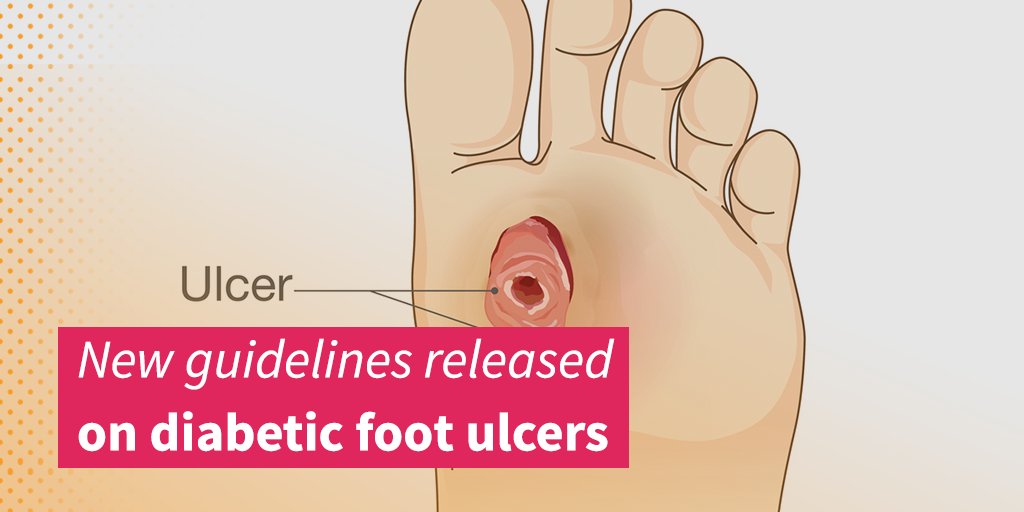Ulcer pain area. Peptic Ulcers: Symptoms, Causes, and Treatment Options
What are the common symptoms of peptic ulcers. How are peptic ulcers diagnosed and treated. What lifestyle changes can help prevent peptic ulcers. What are the potential complications of untreated peptic ulcers. How do H. pylori bacteria and NSAIDs contribute to ulcer formation.
Understanding Peptic Ulcers: Types and Locations
Peptic ulcers are open sores that develop in the lining of the stomach or the upper part of the small intestine. There are two main types of peptic ulcers:
- Gastric ulcers: Located in the stomach
- Duodenal ulcers: Found in the duodenum, the first part of the small intestine
Some individuals may have both types simultaneously. The term “peptic” refers to the role of stomach acid in the formation of these ulcers. Understanding the location and type of ulcer is crucial for proper diagnosis and treatment.
Recognizing the Symptoms of Peptic Ulcers
Peptic ulcers can present with a variety of symptoms, though some individuals may be asymptomatic. The most common symptom is a dull or burning pain in the stomach area, typically between the belly button and breastbone. This pain often:

- Occurs when the stomach is empty, such as between meals or at night
- Temporarily subsides after eating or taking antacids
- Lasts for minutes to hours
- Comes and goes over days, weeks, or months
Other less common symptoms may include:
- Bloating
- Burping
- Nausea
- Poor appetite
- Vomiting
- Weight loss
Is abdominal pain always indicative of a peptic ulcer? No, abdominal pain can have many causes, so it’s essential to consult a healthcare professional for an accurate diagnosis.
The Hidden Danger: Bleeding Ulcers
One of the most serious complications of peptic ulcers is bleeding. This can range from slow, unnoticeable bleeding to life-threatening hemorrhage. Symptoms of a bleeding ulcer may include:
- Anemia (fatigue, shortness of breath with exercise, pale skin)
- Melena (jet black, very sticky stool)
- Dark red or maroon blood in the stool
- Vomiting blood or material resembling coffee grounds
How quickly can a bleeding ulcer become dangerous? Rapid bleeding can lead to severe blood loss and require immediate medical attention. Even slow bleeding can cause serious health issues if left untreated.
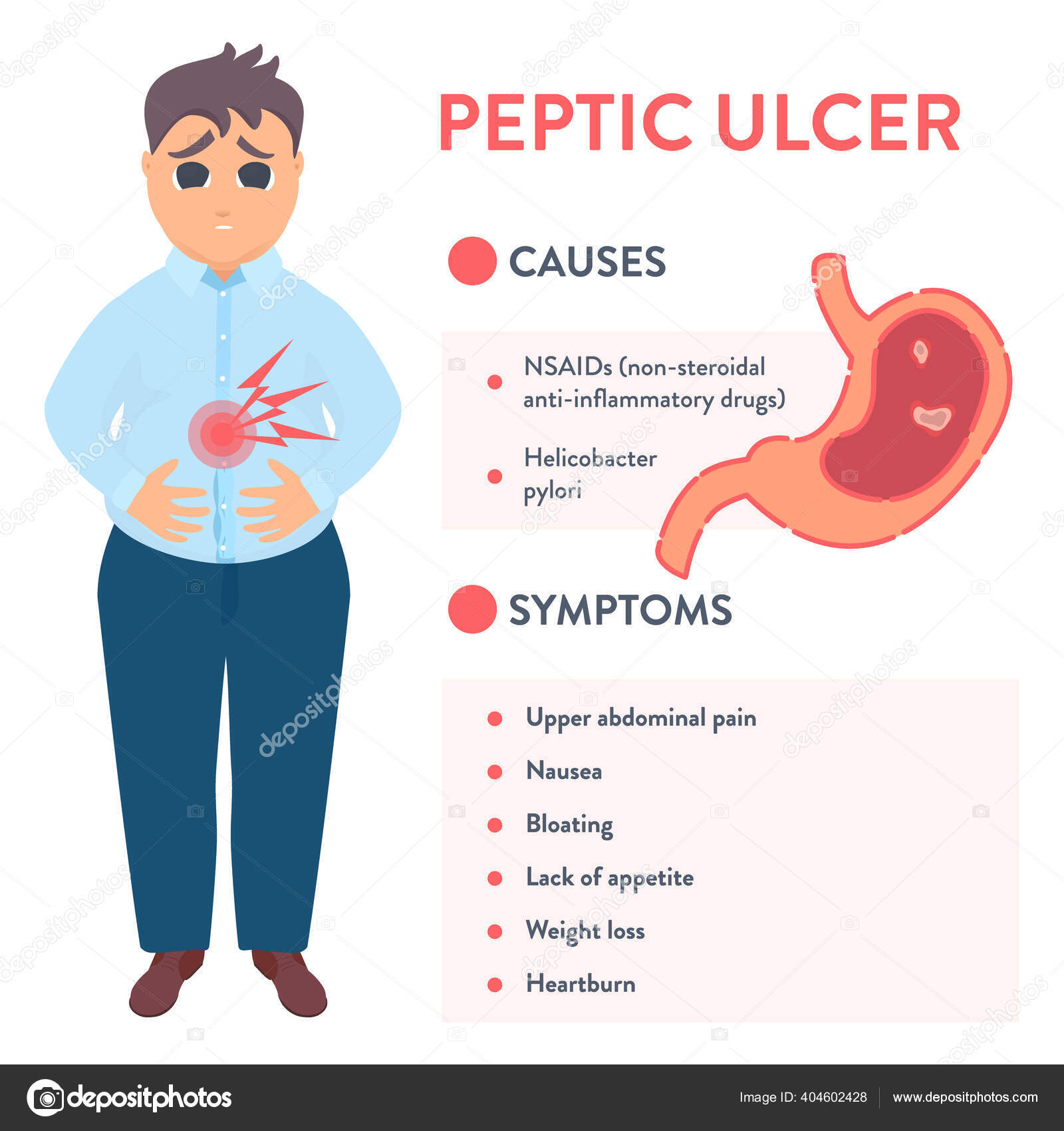
Primary Causes of Peptic Ulcers
Peptic ulcers typically develop due to one or more of the following factors:
- Helicobacter pylori (H. pylori) bacterial infection
- Long-term use of nonsteroidal anti-inflammatory drugs (NSAIDs)
- Zollinger-Ellison syndrome (a rare condition involving tumors that increase acid production)
In some cases, peptic ulcers may be caused by a combination of H. pylori infection and NSAID use. Understanding these causes is crucial for effective prevention and treatment strategies.
The Role of H. pylori in Ulcer Formation
H. pylori are spiral-shaped bacteria that can damage the protective mucous coating of the stomach and duodenum. This damage allows stomach acid to reach the sensitive lining beneath, leading to irritation and ulcer formation. How does H. pylori survive in the harsh stomach environment? These bacteria have evolved to withstand stomach acid, making them particularly troublesome in ulcer development.
NSAIDs and Their Impact on Ulcer Development
Nonsteroidal anti-inflammatory drugs (NSAIDs) work by reducing pain, fever, and inflammation. However, they also decrease the production of chemicals that protect the stomach lining and help control bleeding. This dual action increases the risk of developing peptic ulcers. Which NSAIDs are most commonly associated with ulcer formation? While all NSAIDs can increase ulcer risk, some of the most common culprits include aspirin, ibuprofen, and naproxen.
:max_bytes(150000):strip_icc()/peptic-ulcer-disease-diagnosis-4707600_final-51498411f53a44d8bc49efda9d31e2fd.jpg)
Zollinger-Ellison Syndrome: A Rare Cause of Peptic Ulcers
Zollinger-Ellison syndrome (ZES) is an uncommon disorder characterized by the formation of one or more tumors in the pancreas or duodenum. These tumors, known as gastrinomas, release excessive amounts of the hormone gastrin. This leads to increased stomach acid production, which in turn can cause peptic ulcers. How rare is Zollinger-Ellison syndrome? ZES affects only about 1 in every 1 million people, making it an infrequent cause of peptic ulcers compared to H. pylori infection and NSAID use.
Diagnosing Peptic Ulcers: Tests and Procedures
To diagnose peptic ulcers, healthcare providers may use a combination of the following methods:
- Medical history and physical examination
- Blood tests to check for anemia or H. pylori infection
- Stool tests to detect H. pylori or signs of bleeding
- Upper endoscopy to visualize the stomach and duodenum
- Barium swallow or upper GI series
- Breath test for H. pylori infection
What is the gold standard for diagnosing peptic ulcers? Upper endoscopy is considered the most accurate method for diagnosing peptic ulcers, as it allows direct visualization of the ulcer and the ability to take biopsies if needed.

Treatment Approaches for Peptic Ulcers
The treatment of peptic ulcers typically involves a multi-faceted approach aimed at eliminating the underlying cause and promoting healing. Common treatment strategies include:
- Antibiotics to eradicate H. pylori infection
- Proton pump inhibitors (PPIs) or H2 blockers to reduce stomach acid production
- Discontinuation or reduction of NSAID use
- Protective medications to strengthen the stomach lining
- Lifestyle modifications to reduce risk factors
How long does it typically take for a peptic ulcer to heal with proper treatment? With appropriate treatment, most peptic ulcers heal within 4 to 8 weeks. However, larger or more severe ulcers may take longer to heal completely.
Antibiotic Therapy for H. pylori Eradication
When H. pylori infection is the cause of peptic ulcers, antibiotic therapy is crucial. The standard treatment typically involves a combination of two antibiotics along with a proton pump inhibitor, known as triple therapy. In some cases, a fourth medication may be added (quadruple therapy). What are the most commonly used antibiotics for H. pylori eradication? Clarithromycin, amoxicillin, and metronidazole are frequently prescribed, often in combination with a PPI like omeprazole or lansoprazole.
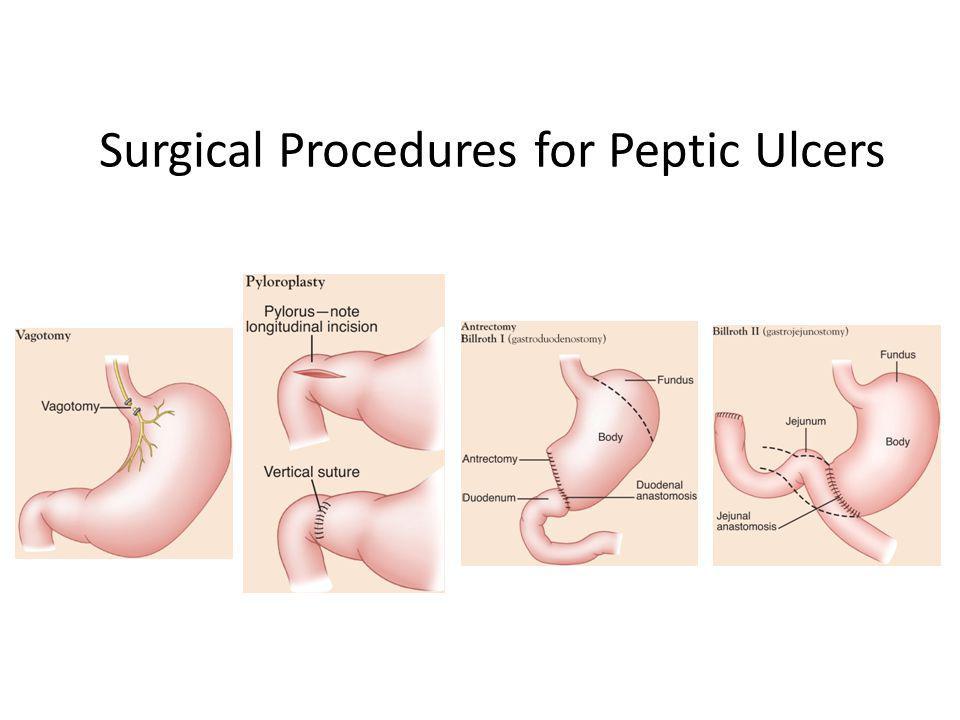
Acid-Suppressing Medications
Reducing stomach acid is a key component of peptic ulcer treatment. Two main classes of medications are used for this purpose:
- Proton pump inhibitors (PPIs): These drugs, such as omeprazole, esomeprazole, and pantoprazole, effectively suppress acid production by blocking the proton pumps in stomach cells.
- H2 blockers: Medications like ranitidine and famotidine work by blocking histamine, which stimulates acid production.
How do PPIs differ from H2 blockers in their effectiveness? PPIs generally provide stronger and longer-lasting acid suppression compared to H2 blockers, making them the preferred choice for most peptic ulcer treatments.
Lifestyle Modifications and Preventive Measures
While medication is often necessary for treating peptic ulcers, certain lifestyle changes can help prevent their occurrence and promote healing:
- Avoiding or limiting NSAID use
- Quitting smoking
- Reducing alcohol consumption
- Managing stress through relaxation techniques or therapy
- Eating a balanced diet rich in fruits, vegetables, and whole grains
- Maintaining a healthy weight
Can dietary changes alone cure peptic ulcers? While a healthy diet can support overall digestive health, it’s typically not sufficient to cure peptic ulcers without appropriate medical treatment. However, certain foods may help alleviate symptoms and support the healing process.
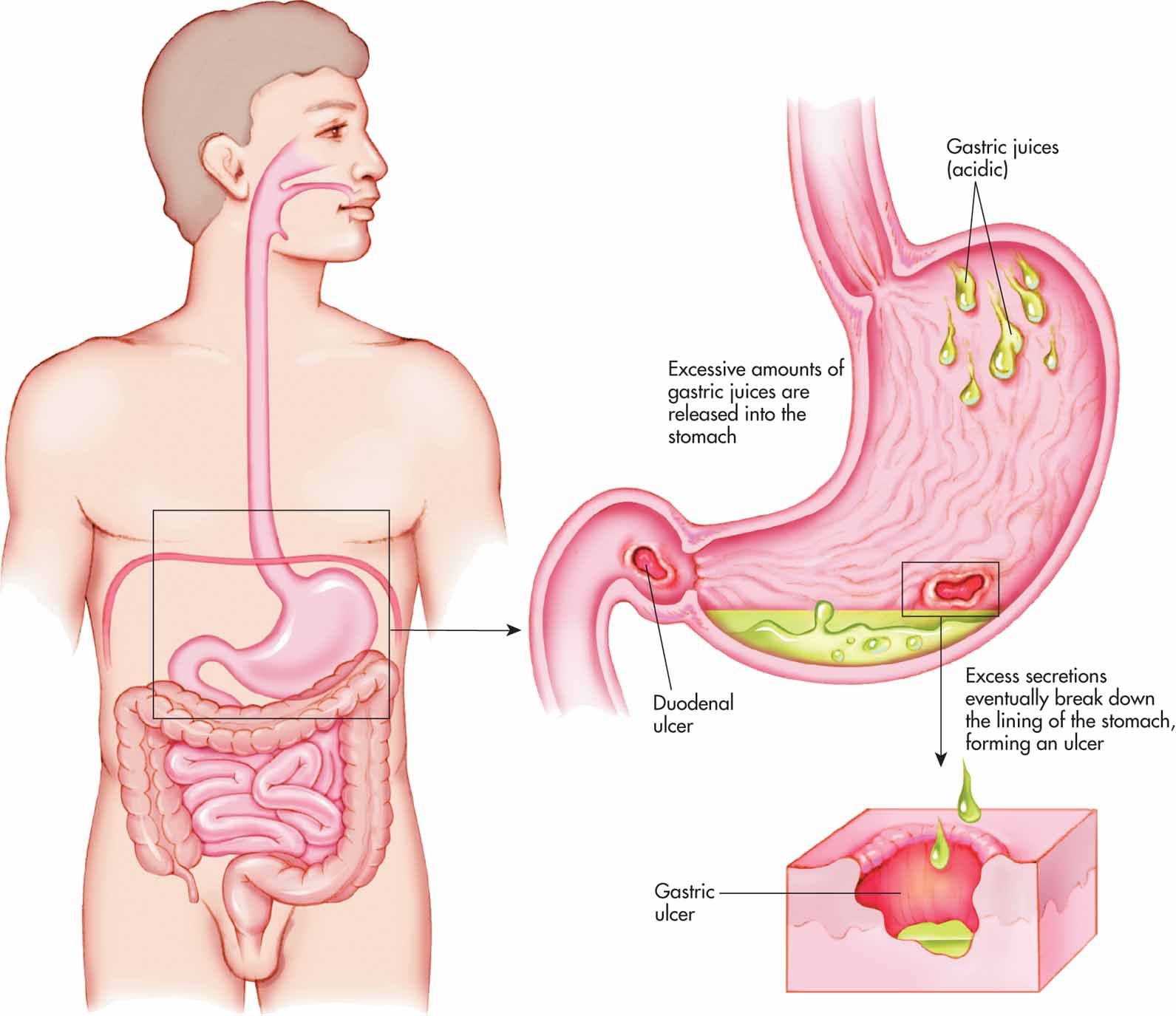
Foods That May Help Soothe Ulcer Symptoms
While there’s no specific “ulcer diet,” some foods may help reduce discomfort and support healing:
- Probiotic-rich foods like yogurt and kefir
- Flavonoid-rich foods such as apples, cranberries, and garlic
- Lean proteins
- High-fiber foods
- Vitamin C-rich foods like bell peppers and broccoli
Are there any foods that should be avoided with peptic ulcers? While individual tolerances may vary, it’s generally advisable to limit or avoid spicy foods, citrus fruits, tomatoes, chocolate, and caffeine, as these may irritate the stomach lining in some people.
Potential Complications of Untreated Peptic Ulcers
If left untreated, peptic ulcers can lead to serious complications, including:
- Internal bleeding
- Perforation (a hole through the stomach or duodenal wall)
- Gastric outlet obstruction (blockage of the passage from the stomach to the small intestine)
- Penetration (ulcer extending into nearby organs like the pancreas or liver)
How common are these complications? While complications occur in only a small percentage of peptic ulcer cases, they can be life-threatening when they do happen. This underscores the importance of prompt diagnosis and treatment.

Warning Signs of Ulcer Complications
Certain symptoms may indicate a more serious problem and require immediate medical attention:
- Sudden, sharp abdominal pain that doesn’t subside
- Vomiting blood or material that looks like coffee grounds
- Black, tarry stools
- Severe weakness or fainting
- Difficulty breathing
When should you seek emergency care for suspected ulcer complications? If you experience any of the above symptoms, especially if they’re severe or accompanied by signs of shock (such as rapid heartbeat, clammy skin, or confusion), seek emergency medical care immediately.
The Future of Peptic Ulcer Treatment and Prevention
Research into peptic ulcer disease continues to evolve, with several promising areas of study:
- New antibiotics and treatment regimens for H. pylori eradication
- Development of gastroprotective medications
- Exploration of probiotics in ulcer prevention and treatment
- Investigation of natural compounds with anti-ulcer properties
- Improved diagnostic techniques for early detection
What role might personalized medicine play in future ulcer treatments? As our understanding of genetic factors influencing ulcer susceptibility and treatment response grows, personalized treatment approaches may become more common, potentially improving outcomes and reducing side effects.
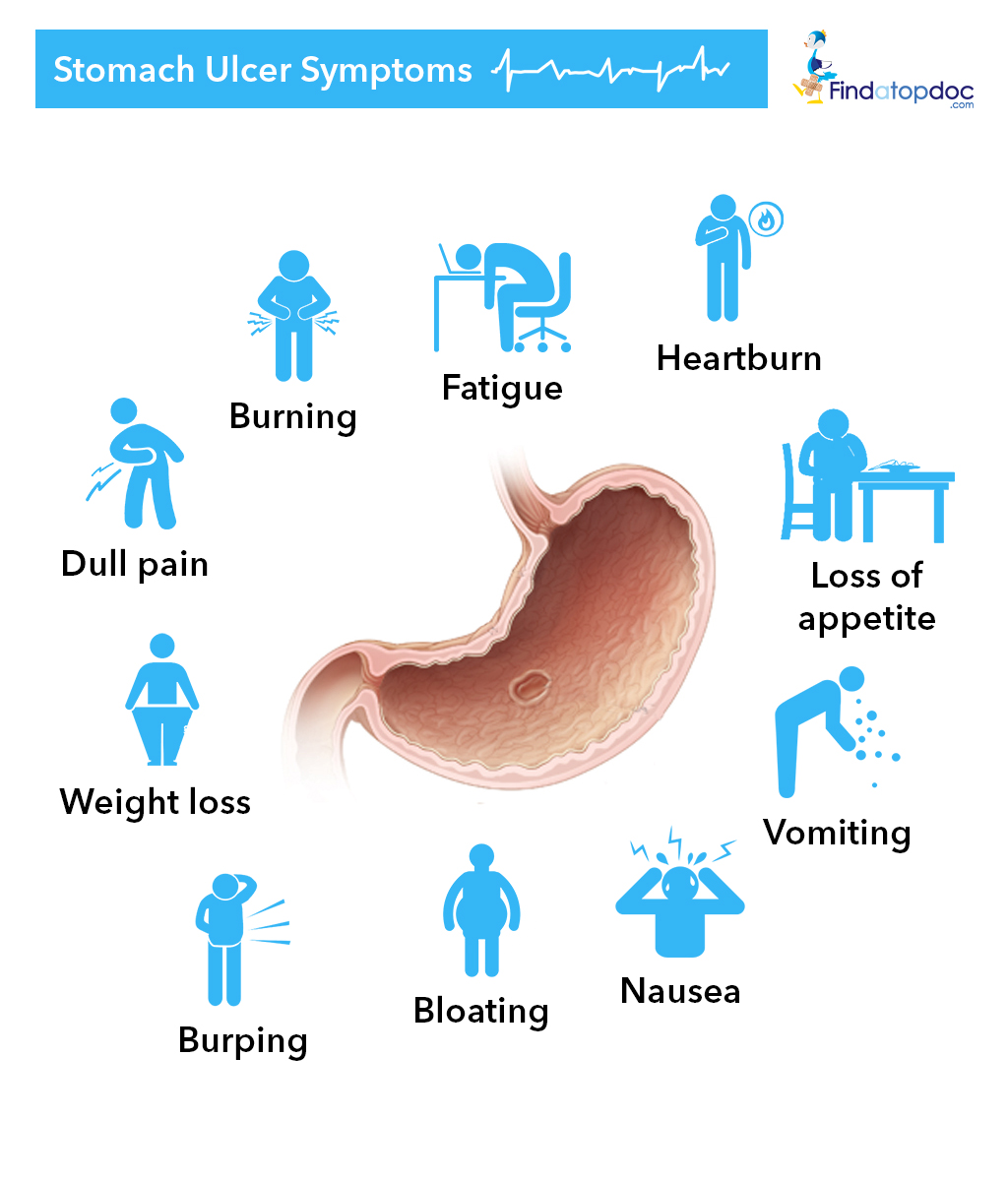
Emerging Research on Ulcer Prevention
Recent studies have highlighted potential strategies for reducing peptic ulcer risk:
- Development of safer NSAID formulations
- Investigation of H. pylori vaccines
- Exploration of dietary factors that may protect against ulcer formation
- Research into the gut microbiome’s role in ulcer development and prevention
How close are we to an effective H. pylori vaccine? While several vaccine candidates have shown promise in clinical trials, an approved H. pylori vaccine for widespread use is likely still several years away. Ongoing research continues to refine vaccine strategies and assess long-term efficacy.
In conclusion, peptic ulcers remain a significant health concern, affecting millions of people worldwide. However, with advances in diagnosis, treatment, and prevention strategies, the outlook for those affected by this condition continues to improve. By understanding the causes, recognizing the symptoms, and seeking prompt medical attention, individuals can effectively manage peptic ulcers and reduce the risk of complications. As research progresses, we can anticipate even more targeted and effective approaches to treating and preventing this common digestive disorder.

Symptoms & Causes of Peptic Ulcers (Stomach Ulcers)
In this section:
What are the symptoms of a peptic ulcer?
A dull or burning pain in your stomach is the most common symptom of a peptic ulcer. You may feel the pain anywhere between your belly button and breastbone. The pain most often
- happens when your stomach is empty—such as between meals or during the night
- stops briefly if you eat or if you take antacids
- lasts for minutes to hours
- comes and goes for several days, weeks, or months
Less common symptoms may include
- bloating
- burping
- feeling sick to your stomach
- poor appetite
- vomiting
- weight loss
Even if your symptoms are mild, you may have a peptic ulcer. You should see your doctor to talk about your symptoms. Without treatment, your peptic ulcer can get worse.
A dull or burning pain in your stomach is the most common symptom of peptic ulcers.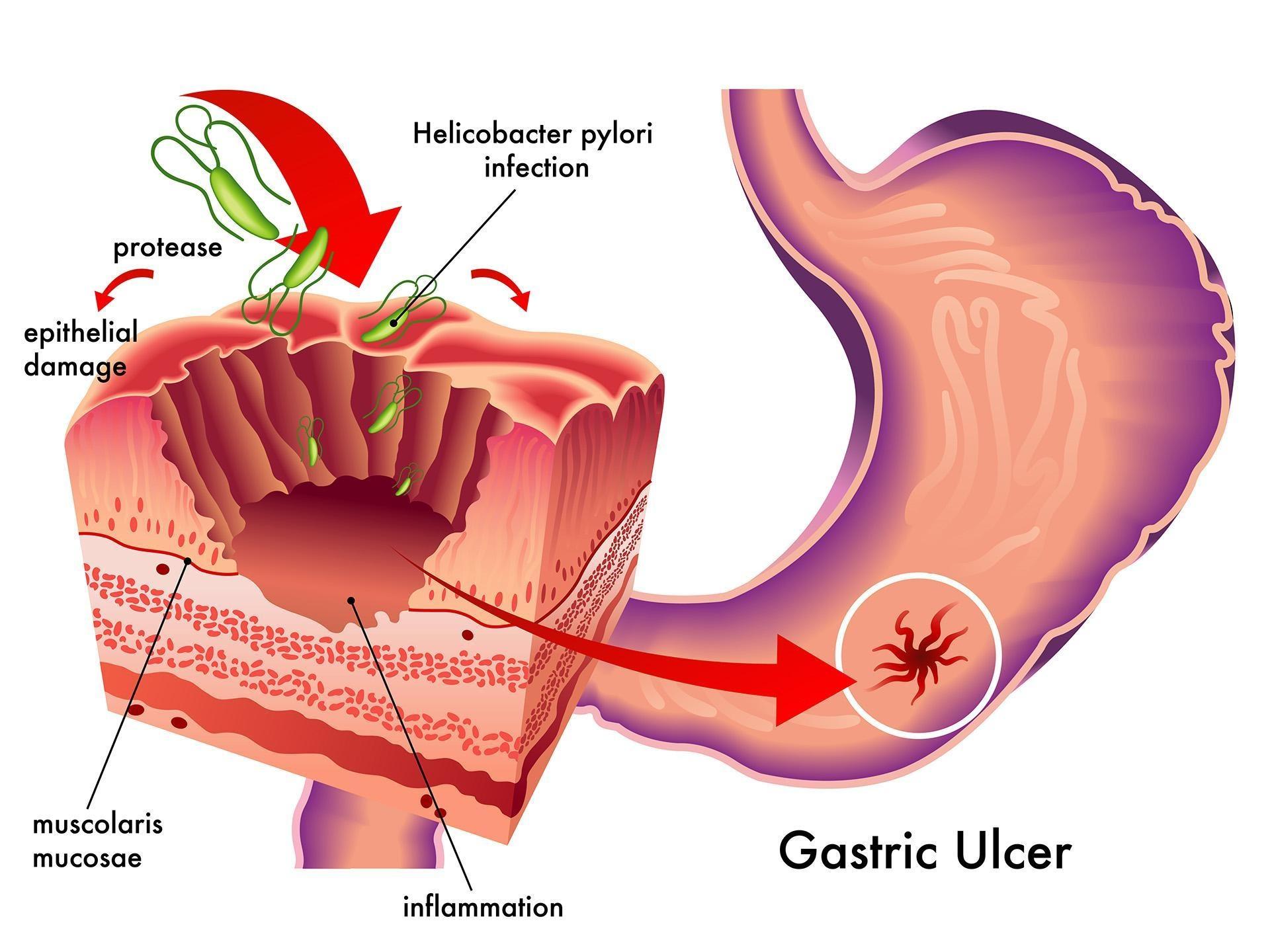
What causes a peptic ulcer?
Causes of peptic ulcers include
Sometimes peptic ulcers are caused by both NSAIDs and H. pylori.
How do NSAIDs cause a peptic ulcer?
To understand how NSAIDs cause peptic ulcer disease, it is important to understand how NSAIDs work. Nonsteroidal anti-inflammatory drugs reduce pain, fever, and inflammation, or swelling.
Everyone has two enzymes that produce chemicals in your body’s cells that promote pain, inflammation, and fever. NSAIDs work by blocking or reducing the amount of these enzymes that your body makes. However, one of the enzymes also produces another type of chemical that protects the stomach lining from stomach acid and helps control bleeding. When NSAIDs block or reduce the amount of this enzyme in your body, they also increase your chance of developing a peptic ulcer.
How do
H. pylori cause a peptic ulcer and peptic ulcer disease?
H. pylori are spiral-shaped bacteria that can cause peptic ulcer disease by damaging the mucous coating that protects the lining of the stomach and duodenum. Once H. pylori have damaged the mucous coating, powerful stomach acid can get through to the sensitive lining. Together, the stomach acid and H. pylori irritate the lining of the stomach or duodenum and cause a peptic ulcer.
Once H. pylori have damaged the mucous coating, powerful stomach acid can get through to the sensitive lining. Together, the stomach acid and H. pylori irritate the lining of the stomach or duodenum and cause a peptic ulcer.
How do tumors from ZES cause peptic ulcers?
Zollinger-Ellison syndrome is a rare disorder that happens when one or more tumors form in your pancreas and duodenum. The tumors release large amounts of gastrin, a hormone that causes your stomach to produce large amounts of acid. The extra acid causes peptic ulcers to form in your duodenum and in the upper intestine.
When should you call or see a doctor?
You should call or see your doctor right away if you
- feel weak or faint
- have difficulty breathing
- have red blood in your vomit or vomit that looks like coffee grounds
- have red blood in your stool or black stools
- have sudden, sharp stomach pain that doesn’t go away
These symptoms could be signs that a peptic ulcer has caused a more serious problem.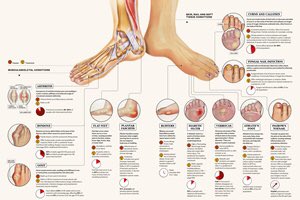
Call your doctor if the pain gets worse.
Peptic Ulcer Disease – American College of Gastroenterology
Overview
An “ulcer” is an open sore. The word “peptic” means that the cause of the problem is due to acid. Most of the time when a gastroenterologist is referring to an “ulcer” the doctor means a peptic ulcer.
The two most common types of peptic ulcer are called “gastric ulcers” and “duodenal ulcers”. These names refer to the location where the ulcer is found. Gastric ulcers are located in the stomach (see Figure 1). Duodenal ulcers are found at the beginning of the small intestine (also called the small bowel) known as the duodenum. A person may have both gastric and duodenal ulcers at the same time.
Figure 1. Photograph of a peptic ulcer taken during an upper endoscopy. This ulcer is a “gastric ulcer” because it is located in the stomach.
Symptoms
Many people with ulcers have no symptoms at all.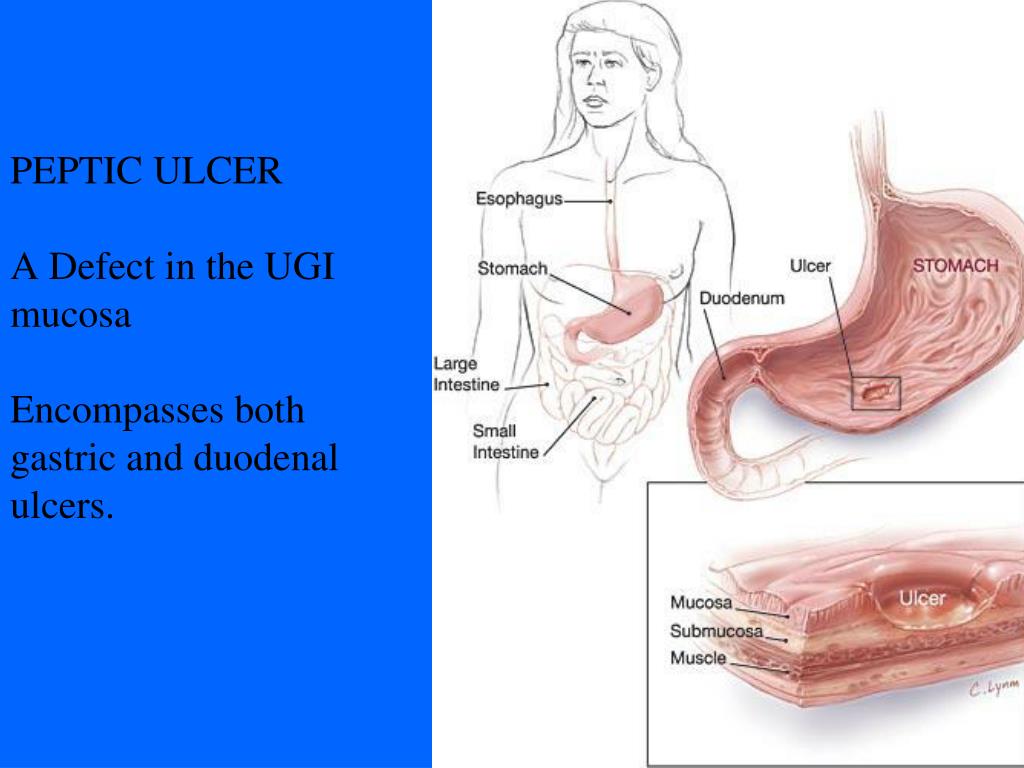 Some people with an ulcer have belly pain. This pain is often in the upper abdomen. Sometimes food makes the pain better, and sometimes it makes it worse. Other symptoms include nausea, vomiting, or feeling bloated or full. It is important to know that there are many causes of abdominal pain, so not all pain in the abdomen is an “ulcer”.
Some people with an ulcer have belly pain. This pain is often in the upper abdomen. Sometimes food makes the pain better, and sometimes it makes it worse. Other symptoms include nausea, vomiting, or feeling bloated or full. It is important to know that there are many causes of abdominal pain, so not all pain in the abdomen is an “ulcer”.
The most important symptoms that ulcers cause are related to bleeding.
Bleeding from an ulcer can be slow and go unnoticed or can cause life-threatening hemorrhage. Ulcers that bleed slowly might not produce the symptoms until the person becomes anemic. Symptoms of anemia include fatigue, shortness of breath with exercise and pale skin color.
Bleeding that occurs more rapidly might show up as melena – jet black, very sticky stool (often compared to “roof tar”) – or even a large amount of dark red or maroon blood in the stool. People with bleeding ulcers may also vomit. This vomit may be red blood or may look like “coffee grounds”. Other symptoms might include “passing out” or feeling lightheaded. Symptoms of rapid bleeding represent a medical emergency. If this occurs, immediate medical attention is needed. People with these symptoms should dial 911 or go to the nearest emergency room.
Other symptoms might include “passing out” or feeling lightheaded. Symptoms of rapid bleeding represent a medical emergency. If this occurs, immediate medical attention is needed. People with these symptoms should dial 911 or go to the nearest emergency room.
Causes/Risk Factors
The two most important causes of ulcers are infection with Helicobacter pylori and a group of medications known as NSAIDs.
Helicobacter pylori (also called H. pylori or “HP) is a bacterium that lives in the stomach of infected people. The understanding that H. pylori can cause ulcers was one of the most important medical discoveries of the late 20th century. In fact, Dr. Barry Marshall and Dr. J. Robin Warren were awarded the 2005 Nobel Prize in Medicine for this discovery.
People infected with H. pylori are at increased risk of developing peptic ulcers. When a person is diagnosed with an ulcer, testing for H. pylori is often done. There are a number of tests to diagnose H. pylori and the type of test used depends on the situation.
pylori is often done. There are a number of tests to diagnose H. pylori and the type of test used depends on the situation.
People with ulcers. who are infected with H. pylori. should have their infection treated. Treatment usually consists of taking either three or four drugs. The drug therapy will use acid suppression therapy with a proton pump inhibitor (PPI) along with antibiotic therapy and perhaps a bismuth containing agent such as Pepto-Bismol. H. pylori can be very difficult to cure; so it is very important that people being treated for this infection take their entire course of antibiotics as prescribed.
NSAIDs (Non-Steroidal Anti-Inflammatory Drugs) are a group of medications typically used to treat pain. There are many drugs in this group. A few of these include: aspirin (Bayer®), ibuprofen (Motrin®, Advil®), naproxen (Aleve®, Naprosyn®), ketorolac (Toradol®) and oxaprozin (Daypro®).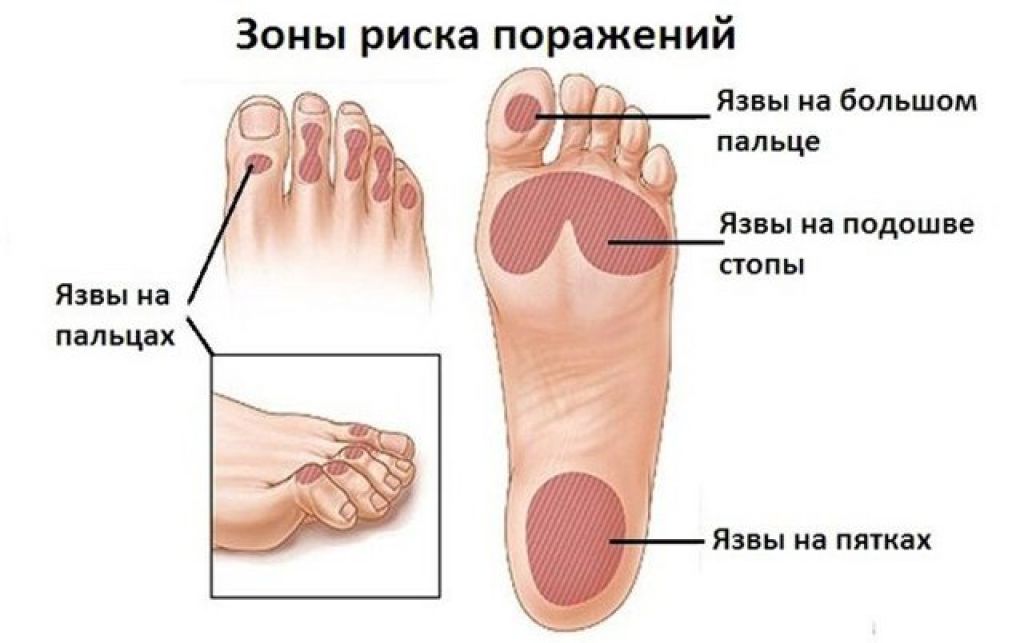 NSAIDs are also included in some combination medications, such as Alka-Seltzer®, Goody’s Powder® and BC Powder®.
NSAIDs are also included in some combination medications, such as Alka-Seltzer®, Goody’s Powder® and BC Powder®.
Acetaminophen (Tylenol®) is NOT an NSAID and is therefore the preferred non-prescription treatment for pain in patients at risk for peptic ulcer disease.
NSAID use is very common because many are available over the counter without a prescriptionand therefore they are a very common cause of peptic ulcers. NSAIDs cause ulcers by interrupting the natural ability of the stomach and the duodenum to protect themselves from stomach acid. NSAIDs also can interfere with blood clotting, which has obvious importance when ulcers bleed.
People who take NSAIDs for a long time and/or at high doses, have a higher risk of developing ulcers. These people should discuss the various options for preventing ulcers with their physician. Some people are given an acid suppressing PPI. These drugs can prevent or significantly reduce the risk of an ulcer being caused by NSAIDs.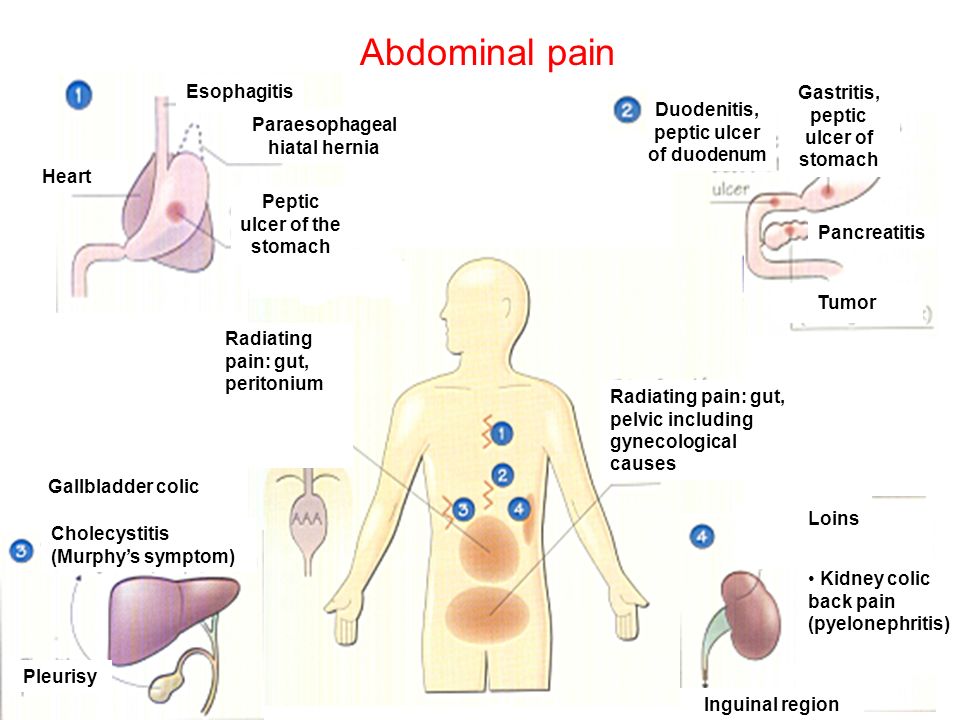
There are many myths about peptic ulcers. Ulcers are not caused by emotional “stress” or by worrying. They are not caused by spicy foods or a rich diet. Certain foods might irritate an ulcer that is already there, however, the food is not the cause of the ulcer. People diagnosed with ulcers do not need to follow a specific diet. The days of ulcer patients surviving on a bland diet are a thing of the past.
Diagnosis
The most typical way for ulcers to be diagnosed is by a procedure called an EGD. EGD stands for EsophagoGastroDuodenoscopy. An EGD (also called “upper endoscopy”) is performed by inserting a special lighted camera on a flexible tube into the person’s mouth to look directly into the stomach and the beginning of the small bowel. This flexible camera carefully inspects the most likely areas for ulcers to be located. Ulcers identified during an EGD may be photographed, biopsied and even treated, if bleeding is present.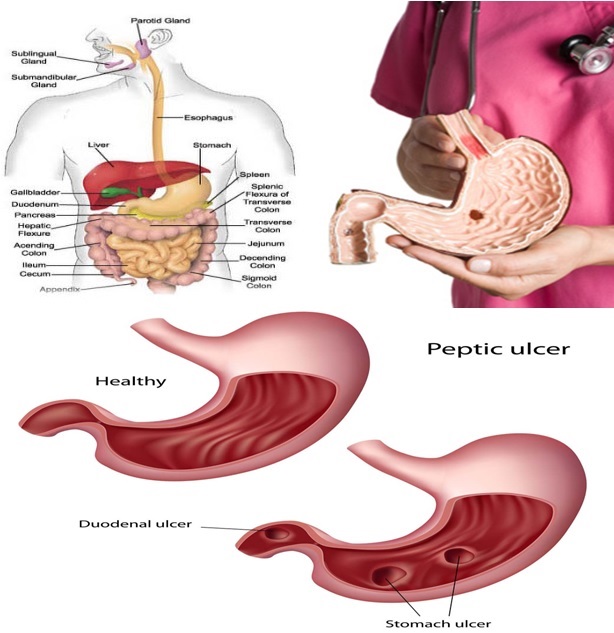
Another way ulcers were diagnosed in the past was with an x-ray test called an “upper GI series”. An upper GI series involves drinking a white chalky substance called barium, and then taking a number of x-rays to look at the lining of the stomach. Doctors can see the ulcers on the x-rays when they have barium in them.
Today, the preferred method for diagnosing ulcers is with an EGD given the flexible camera is better able to detect even small ulcers and because it allows for potential treatment at that time if the ulcer is bleeding. An upper GI series can miss small ulcers and also does not allow direct treatment of an ulcer.
Treatment
The way that ulcers are treated depends on a number of features. Nearly all peptic ulcers will be treated with a proton pump inhibitor (PPI). PPIs are powerful acid blocking drugs that can be taken as a pill or given in an IV. Often, the potent IV form is used if a patient is hospitalized with a bleeding ulcer. There are six PPIs available in the United States. These are omeprazole (Prilosec®, Zegerid®), lansoprazole (Prevacid®), pantoprazole (Protonix®), rabeprazole (Aciphex®), esomeprazole (Nexium®), and dexlansoprazole (Dexilant®). There are very few medical differences between these drugs.
There are six PPIs available in the United States. These are omeprazole (Prilosec®, Zegerid®), lansoprazole (Prevacid®), pantoprazole (Protonix®), rabeprazole (Aciphex®), esomeprazole (Nexium®), and dexlansoprazole (Dexilant®). There are very few medical differences between these drugs.
PPIs require a meal to activate them. Patients should eat a meal within 30 minutes to 1 hour after taking this medication for the acid suppression therapy to work most effectively. Waiting later than this time can decrease the positive effect of this medication. This might delay healing or even result in the failure of the ulcer to heal.
An important part in treating ulcers is by identifying what caused them Patients with ulcers caused by NSAIDs should talk to their doctor about other medications that can be used to treat pain.
If the person is infected with H. pylori this infection should be treated.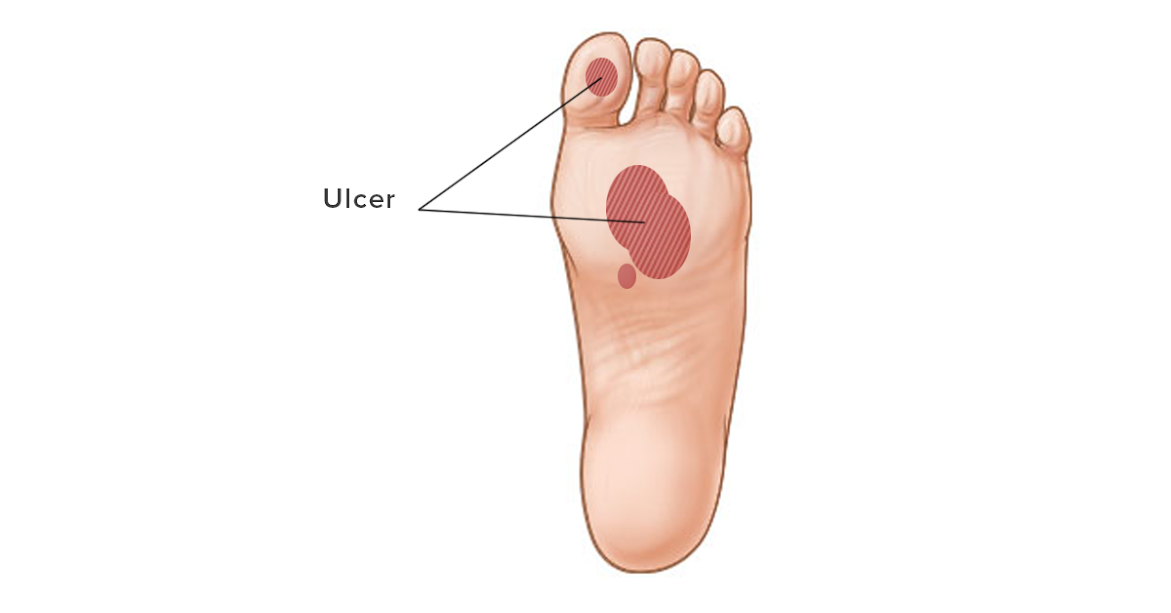 Completing the full dose of antibiotics is very important. Just as important, is making sure that the infection is gone. There are number of ways to do this. Generally, a blood test is not a good way to test if the infection is gone. The doctor who treated the infection can recommend the best way to do the “test of cure”.
Completing the full dose of antibiotics is very important. Just as important, is making sure that the infection is gone. There are number of ways to do this. Generally, a blood test is not a good way to test if the infection is gone. The doctor who treated the infection can recommend the best way to do the “test of cure”.
When someone has an ulcer that has bled significantly, treatment might be done at the time of EGD. There are a number of techniques that can be performed during an EGD to control bleeding from an ulcer. The gastroenterologist might inject medications, use a catheter to cauterize the ulcer (burn a bleeding vessel shut) or place a small clip to clamp off a bleeding vessel. Not all ulcers need to be treated this way. The doctor doing the EGD will decide if treatment is indicated based on the way the ulcer looks. The doctor will usually treat an ulcer that is actually bleeding when it is seen and will also often treat other ulcers if they have a certain appearance./peptic-ulcer-disease-diagnosis-750efa52cc704ddc8df540bcdd580bde.jpg) These findings are sometimes called “stigmata of recent hemorrhage” or just “stigmata”. Stigmata will usually get treated during the EGD if they are classified as high-risk. Common high-risk findings include a “visible vessel” and an “adherent clot”.
These findings are sometimes called “stigmata of recent hemorrhage” or just “stigmata”. Stigmata will usually get treated during the EGD if they are classified as high-risk. Common high-risk findings include a “visible vessel” and an “adherent clot”.
Most ulcers can be treated and will heal. Often, people with ulcers will have to take PPIs for several weeks to heal an ulcer. It is also important to correct what caused the ulcer. When possible, NSAIDs should be stopped. Patients with ulcers caused by NSAIDs should talk to their doctor about other medications that can be used to treat pain.
If the person is infected with H. pylori, then completing the full dose of antibiotics is very important. Just as important, is making sure that the infection is gone. There are number of ways to do this. Generally, a blood test is not a good way to test if the infection is gone. The doctor who treated the infection can recommend the best way to do the “test of cure”.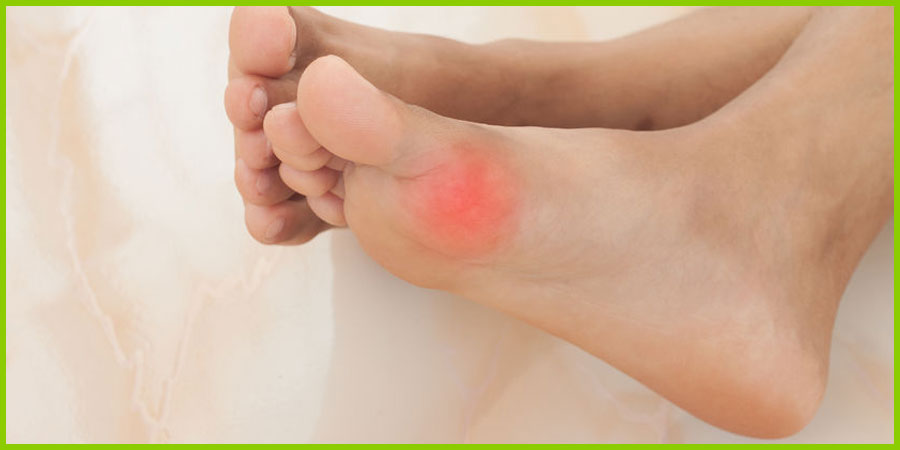
People with gastric ulcers (only in the stomach) usually have another EGD several weeks after treatment to make sure that the ulcer is gone. This is because a very small number of gastric ulcers might contain cancer. Duodenal ulcers (at the beginning of the small intestine) usually don’t need to be looked at again.
Glossary
Anemia – A low red blood cell count. Symptoms of anemia include feeling tired, shortness of breath, weakness and poor exercise tolerance.
Duodenal – referring to the beginning of the small intestine or duodenum.
EGD – EsophagoGastroDuodenoscopy, also called “upper endoscopy” is a medical procedure where a flexible lighted tube with a camera is inserted through the person’s mouth and into the stomach and duodenum to diagnose or treat disease.
Erosion – a very shallow sore, similar to an abrasion or a scrape. These are usually not very important and very rarely cause symptoms.
These are usually not very important and very rarely cause symptoms.
Gastric – referring to the stomach.
h3 blocker – h3 blockers significantly lower the production of acid in the stomach. They are sometimes used to treat duodenal (not gastric) ulcers. They are also often used to treat heartburn and GERD. Common h3 blockers are ranitidine (Zantac®), cimetidine (Tagamet®), famotidine (Pepcid®) and nizatidine (Axid®).
Helicobacter pylori – sometimes called H. pylori or HP is a bacterium that causes ulcers. H. pylori is also a risk factor for stomach cancer. If prescribed, it is very important to complete an entire course of antibiotics for H. pylori.
Melena – black very sticky stool, often compared to roof tar. This is a common symptom of a bleeding ulcer. Black stool that looks like melena can be caused by taking iron medications and by drugs like Pepto-Bismol®.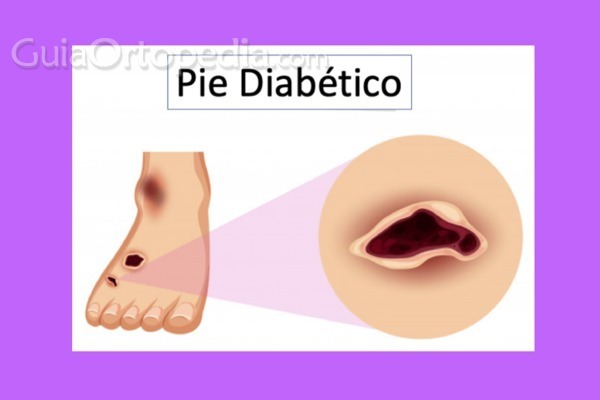
NSAIDs – (Non-Steroidal Anti-Inflammatory Drugs) are a group of medications typically used to treat pain. There are many drugs in this group. A few of these include: aspirin (Bayer®), ibuprofen (Motrin®, Advil®), naproxen (Aleve®, Naprosyn®), ketorolac (Toradol®) and oxaprozin (Daypro®). NSAIDs are also included in some combination medications, such as Alka-Seltzer®. Acetaminophen (Tylenol®) is NOT an NSAID and is therefore the preferred non-prescription treatment for pain in patients at risk for peptic ulcer disease.
Peptic – caused by acid.
PPIs – Proton Pump Inhibitors. Powerful acid blocking drugs that can be taken as a pill or given in an IV. PPIs are frequently used to treat ulcers, and also heartburn and GERD. There are six PPIs available in the United States. These are omeprazole (Prilosec®, Zegerid®), lansoprazole (Prevacid®), pantoprazole (Protonix®), rabeprazole (Aciphex®), esomeprazole (Nexium®) and dexlansoprazole (Dexilant®). There are very few medical differences between these drugs. It is important to know that PPIs require a meal to activate them. Patients should eat a meal within 30 minutes to 1 hour after taking this medication for the acid suppression therapy to work properly.
These are omeprazole (Prilosec®, Zegerid®), lansoprazole (Prevacid®), pantoprazole (Protonix®), rabeprazole (Aciphex®), esomeprazole (Nexium®) and dexlansoprazole (Dexilant®). There are very few medical differences between these drugs. It is important to know that PPIs require a meal to activate them. Patients should eat a meal within 30 minutes to 1 hour after taking this medication for the acid suppression therapy to work properly.
Stigmata of recent hemorrhage – sometimes just called “stigmata” are findings during an EGD that indicate a higher risk of bleeding or re-bleeding. Stigmata are usually treated during the EGD when they are found. This treatment reduces the chance of bleeding.
Ulcer – an open sore. Ulcers are deeper than erosions.
Author(s) and Publication Date(s)
Sean P. Caufield, MD, Lieutenant Commander, Medical Corps, U. S. Navy, Gastroenterology Fellow, Naval Medical Center, San Diego, CA, and Theodore W. Schafer, MD, FACP, FACG, Captain, Medical Corps, U.S. Navy, Associate Professor of Medicine, Uniformed Services University of the Health Sciences, Bethesda, MD – Updated December 2012.
S. Navy, Gastroenterology Fellow, Naval Medical Center, San Diego, CA, and Theodore W. Schafer, MD, FACP, FACG, Captain, Medical Corps, U.S. Navy, Associate Professor of Medicine, Uniformed Services University of the Health Sciences, Bethesda, MD – Updated December 2012.
Theodore W. Schafer, MD, FACP, Commander, Medical Corps, U.S. Navy, Uniformed Services University of the Health Sciences, Bethesda, MD – Published November 2007.
Disclaimer: The views expressed in this article are those of the authors and do not reflect the official policy or position of the Department of the Navy, Department of Defense, or the United States Government.
Return to Top
Peptic Ulcers (for Parents) – Nemours Kidshealth
Many people think that spicy foods cause peptic ulcers, but the truth is that bacteria called Helicobacter pylori (or H. pylori) are the main culprit.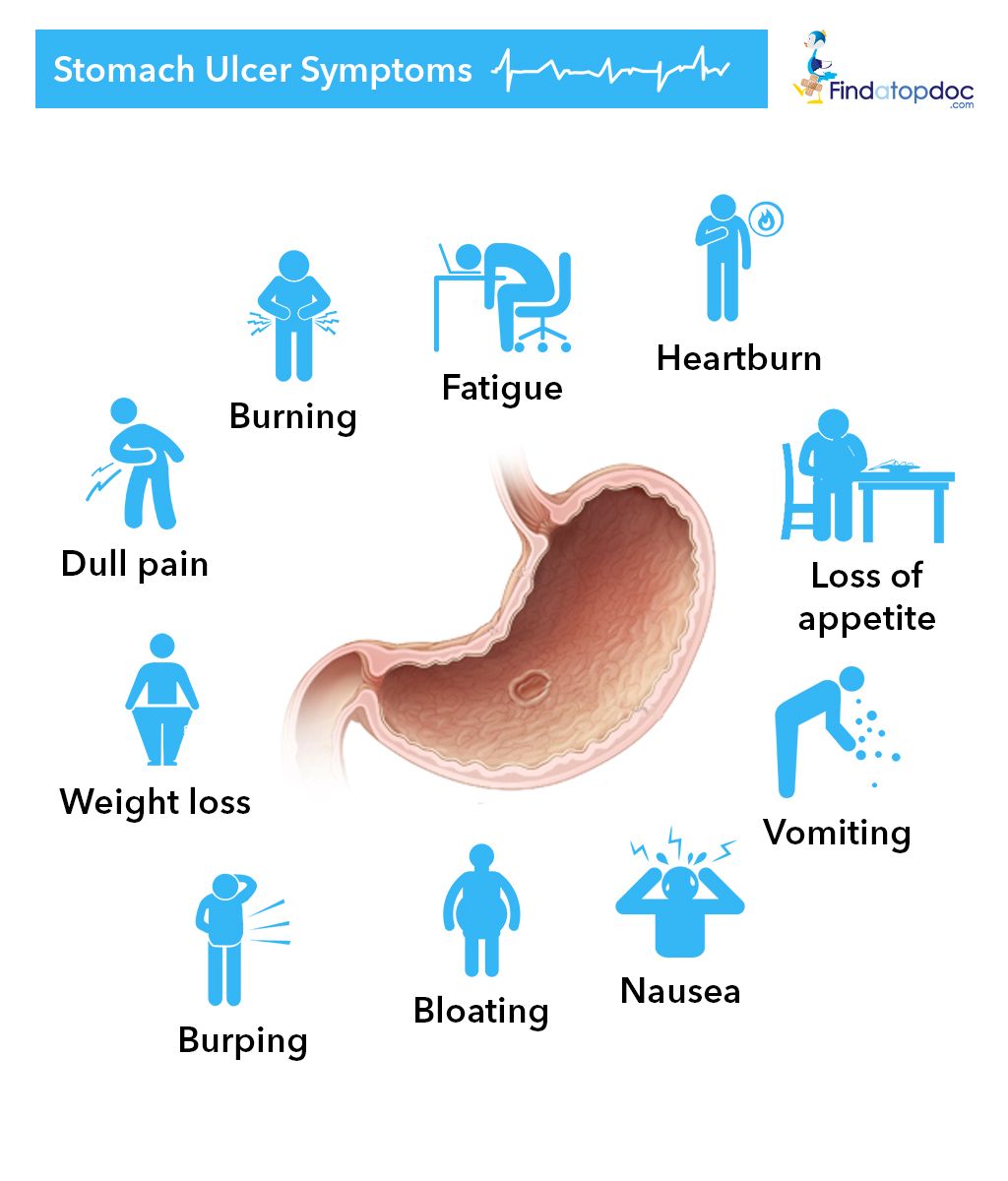 And while many believe that adults in high-stress jobs are the only ones affected, people of any age — even kids — can develop ulcers.
And while many believe that adults in high-stress jobs are the only ones affected, people of any age — even kids — can develop ulcers.
About Peptic Ulcers
An ulcer is a sore, which means it’s an open, painful wound. Peptic ulcers are ulcers that form in the stomach or the upper part of the small intestine, called the duodenum. An ulcer in the stomach is called a gastric ulcer and an ulcer in the duodenum is called a duodenal ulcer.
Both a gastric ulcer and a duodenal ulcer happen when H. pylori or a drug weakens the protective mucous coating of the stomach and duodenum, letting acid get through to the sensitive lining beneath. Both the acid and the bacteria can irritate the lining and cause an ulcer.
H. pylori infection is usually contracted in childhood (perhaps through food, water, or close contact with an infected individual), but most people won’t have any symptoms until they’re older. Although H. pylori infection usually doesn’t cause problems in childhood, it can cause gastritis (irritation and inflammation of the stomach lining), peptic ulcer disease, and even stomach cancer later in life.
Although H. pylori infection usually doesn’t cause problems in childhood, it can cause gastritis (irritation and inflammation of the stomach lining), peptic ulcer disease, and even stomach cancer later in life.
In the past, having peptic ulcers meant living with a chronic condition for several years or even a lifetime. But today, a better understanding of the cause of peptic ulcers and how to treat them means that most people can be cured.
Page 1
Causes of Peptic Ulcers in Kids
Although stress and certain foods may aggravate an ulcer, most ulcers are caused by an H. pylori infection or the use of common nonsteroidal anti-inflammatory drugs (NSAIDs) such as ibuprofen.
However, while most experts agree that H. pylori infection is a top cause of peptic ulcers in adults, not all think that the bacteria are a major culprit in childhood ulcers. Some doctors make the distinction between duodenal ulcers, which are commonly associated with H. pylori infection, and gastric ulcers, which may stem from other causes.
pylori infection, and gastric ulcers, which may stem from other causes.
It’s recognized that certain medical conditions can contribute to the development of ulcers. For instance, children with severe burns can develop ulcers secondary to the stress of their injuries. This is also true for infants who become septic (very ill with a bacterial infection). In otherwise healthy kids, peptic ulcers are very unusual.
Some doctors believe that more kids get drug-related gastric ulcers than other types of peptic ulcers. Even moderate use of NSAIDs can cause gastrointestinal problems and bleeding in some children. Acetaminophen does not cause stomach ulcers and is a good alternative to NSAIDs for most childhood conditions.
Signs and Symptoms
Although peptic ulcers are rare in kids, if your child has any of these signs and symptoms, call your doctor:
- burning pain in the abdomen between the breastbone and the belly button (the most common ulcer symptom)
- nausea
- vomiting
- chest pain (usually dull and achy)
- loss of appetite
- frequent burping or hiccuping
- weight loss
- feeding difficulties
- blood in vomit or bowel movements, which may appear dark red or black
These signs and symptoms are common in many childhood illnesses and don’t necessarily indicate an ulcer, but they should be reported to your doctor. Based on your child’s medical history and symptoms, the doctor may refer your child to a pediatric gastroenterologist (a doctor who specializes in disorders of the stomach, intestines, and associated organs) for further evaluation.
Based on your child’s medical history and symptoms, the doctor may refer your child to a pediatric gastroenterologist (a doctor who specializes in disorders of the stomach, intestines, and associated organs) for further evaluation.
Page 2
Diagnosis
The doctor may do an upper gastrointestinal (GI) series to get a close look at your child’s gastrointestinal tract. An upper GI series is a set of X-rays of the esophagus, stomach, and duodenum.
The doctor may also order an upper endoscopy, especially if an ulcer is suspected. This procedure, performed under sedation, involves inserting an endoscope — a small, flexible tube with a tiny camera on the end — down the throat and into the stomach and duodenum. It lets the doctor see the lining of the esophagus, stomach, and duodenum to check for possible ulcers, inflammation, or food allergies. It also can be used to perform tissue tests to check for H. pylori.
The endoscopy is sometimes used with a test called a pH probe in which a small wire is inserted into the lower part of the esophagus to measure the amount of acid going into that area.
If there’s any evidence of inflammation, the doctor will test for H. pylori. This test is important because treatment for an ulcer caused by H. pylori is different from the treatment for an ulcer caused by NSAIDs.
H. pylori may be diagnosed through:
- tissue tests (performed during an endoscopy)
- blood tests (which can detect the presence of H. pylori antibodies; blood tests are easy to perform, although a positive test may indicate exposure to H. pylori in the past and not an active infection)
- stool tests (which can detect the presence of H. pylori antigens; stool tests are becoming more common for detecting H. pylori, and some doctors think they’re more accurate than blood tests)
- breath tests (which can detect carbon broken down by H. pylori after the patient drinks a solution; breath tests are also used mostly in adults)
Page 3
Treatment
The good news is that most H. pylori-related ulcers are curable with treatment that combines two different kinds of antibiotics and an acid suppressor. The antibiotics are taken over a 1- to 2-week period and the antacid is given for 2 months or longer. The ulcer may take 8 weeks to heal, but the pain usually goes away after a few days or a week.
pylori-related ulcers are curable with treatment that combines two different kinds of antibiotics and an acid suppressor. The antibiotics are taken over a 1- to 2-week period and the antacid is given for 2 months or longer. The ulcer may take 8 weeks to heal, but the pain usually goes away after a few days or a week.
To be sure the treatment has worked, doctors may order a stool test to verify the absence of H. pylori. If symptoms last or get worse, doctors might do a follow-up endoscopy 6 to 12 months later to check for H. pylori.
Ulcers related to NSAID use rarely require surgery and usually improve with an acid suppressor and stopping or changing the NSAID. No antibiotics are needed to treat this type of ulcer.
Caring for Your Child
If your child is diagnosed with an H. pylori-related ulcer, make sure he or she takes all of the antibiotics as directed by the doctor. Even if the symptoms disappear, the infection may not be gone until all of the medicine has been taken.
If your child has a medication-related ulcer, the doctor will tell you to avoid NSAIDs, including any medicines that contain ibuprofen or aspirin. Also, be sure to give your child the prescribed acid-reducing medicine.
Unless a particular food is bothersome, most doctors don’t recommend dietary restrictions for kids with ulcers. A good diet with a variety of foods is essential to all kids’ growth and development.
Alcohol and smoking can aggravate an ulcer. Also make sure that your child avoids coffee, tea, sodas, and foods that contain caffeine, which can stimulate the secretion of acid in the stomach and may make an ulcer worse.
Page 4
When to Call the Doctor
Call your doctor immediately if your child has any of these symptoms:
- sudden, sharp, lasting belly pain
- bloody or black bowel movements
- bloody vomit or vomit that looks like coffee grounds
For a child with peptic ulcer disease, the symptoms above could indicate a serious problem, such as:
- perforation (when the ulcer becomes too deep and breaks through the stomach or duodenal wall)
- bleeding (when acid or the ulcer breaks a blood vessel)
- obstruction (when the ulcer blocks the path of food from going through the intestines)
If your child is taking NSAIDs and shows symptoms of peptic ulcer disease, get prompt medical help.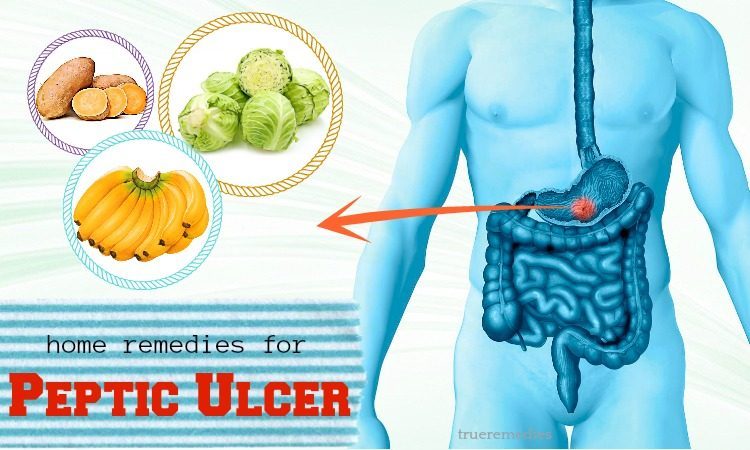 Delaying diagnosis and treatment can lead to complications and, possibly, the need for surgery. But with timely treatment, almost all peptic ulcers can be cured.
Delaying diagnosis and treatment can lead to complications and, possibly, the need for surgery. But with timely treatment, almost all peptic ulcers can be cured.
What Causes Ulcers? | Everyday Health
People with ulcers can have a wide variety of symptoms. Some people may experience no symptoms at all, or in rare instances can develop life — threatening complications, such as bleeding. Some of the more common symptoms may include abdominal pain, burning, nausea, bloating, fatigue, or black stools.The two most common causes of ulcers are Helicobacter pylori (H. pylori) and non steroidal anti — inflammatory drugs (NSAIDS).
H. pylori is a bacteria which causes ulcers by disrupting the protective mucous layer that lines the intestines. When the mucus layer is disrupted, it triggers the release of certain enzymes and toxins that injure the cells of the stomach or duodenum causing small sores. Once a small sore develops, the tissue becomes more vulnerable to damage from digestive juices and has the potential to develop into an ulcer.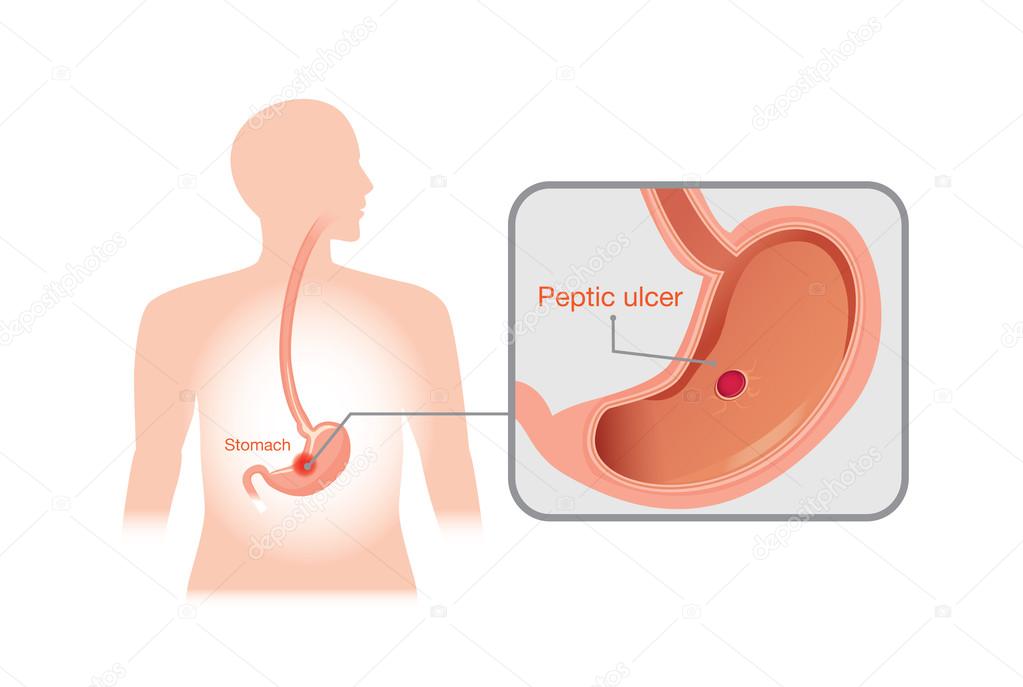
The most common NSAIDS are ibuprofen and aspirin. These types of drugs are taken to decrease inflammation. Inflammation is caused by a natural chemical in the body called prostaglandins. NSAIDS work by inhibiting the body’s production of prostaglandins. However, certain prostaglandins are important in protecting the stomach lining from the corrosive effects of stomach acid, as well as playing a role in maintaining the natural, healthy condition of the stomach lining. By disrupting the production of prostaglandins in the stomach, NSAIDs can cause ulcers and bleeding.
Elisa Faybush, MD (bannerhealth.com)
The majority of peptic ulcers are caused by a bacterial infection of the stomach called Helicobacter pylori. This infection is often asymptomatic and can be acquired in childhood. The other cause of ulcers is the regular use of aspirin and anti — inflammatory medicines. There is no evidence that stress causes ulcers. Symptoms of ulcers can include upper abdominal pain, nausea and vomiting, and black, tarry stools (a sign of a bleeding ulcer).
Lisa Ganjhu, DO (wehealnewyork.org)
A gastric ulcer is a sore or scar in the stomach. Taking high — dose aspirin and nonsteroidal antinflammatory drugs like Motrin or Advil usually cause ulcer in the stomach. Ulcers can also be caused by an infection, called H. pylori. Common symptoms of gastric ulcers include weight loss, poor appetite, bloating, burping, vomiting, and sometimes vomiting blood.
Brett Lashner, MD (clevelandclinic.org)
Ulcers of the stomach and duodenum used to be very common, but are now becoming much less common. We used to think that acid caused ulcers and our treatment paradigm was “no acid, no ulcers.” Yes, eliminating acid allowed ulcers to heal, but they came right back after treatment was stopped. We now know that ulcers are principally related to two causes, Helicobacter pylori infection and non — steroidal anti — inflammatory drug (NSAID) use. By eradicating H. pylori with antibiotics, we can eliminate ulcer disease for good.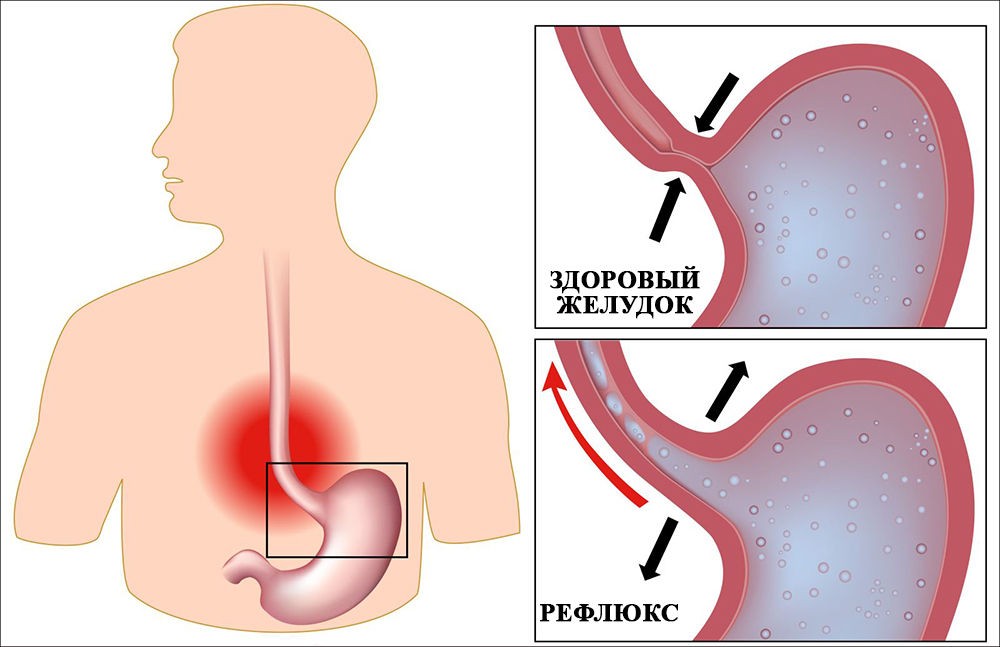 This discovery, that a chronic disease can be cured with antibiotic therapy, led to the awarding of the Nobel Prize in Medicine to Drs. Marshall and Warren in 2005. Interestingly, rates of H. pylori infection are falling, accounting for the lower rates of ulcer disease. Of course, stopping NSAIDs will cure NSAID — induced ulcers. Neither ulcers nor antacid therapy, like proton — pump inhibitors, impact on digesting very much. Digestion occurs more efficiently in the presence of acid, but occurs very well indeed when acid is suppressed.
This discovery, that a chronic disease can be cured with antibiotic therapy, led to the awarding of the Nobel Prize in Medicine to Drs. Marshall and Warren in 2005. Interestingly, rates of H. pylori infection are falling, accounting for the lower rates of ulcer disease. Of course, stopping NSAIDs will cure NSAID — induced ulcers. Neither ulcers nor antacid therapy, like proton — pump inhibitors, impact on digesting very much. Digestion occurs more efficiently in the presence of acid, but occurs very well indeed when acid is suppressed.
Andrew Sable, MD (gastrohealth.com)
Most commonly ulcers occur in either the stomach or duodenum (first part of the small intestine). Symptoms usually manifest as pain or burning in your mid to upper abdomen just below the center of your chest. For years it was thought that stress was a major factor in the formation of ulcers. While severe stress experienced form medical illness may increase the risk of ulcer formation, more commonly medication such as NSAIDs (non — steroidal anti — inflammatory medications), the bacteria H.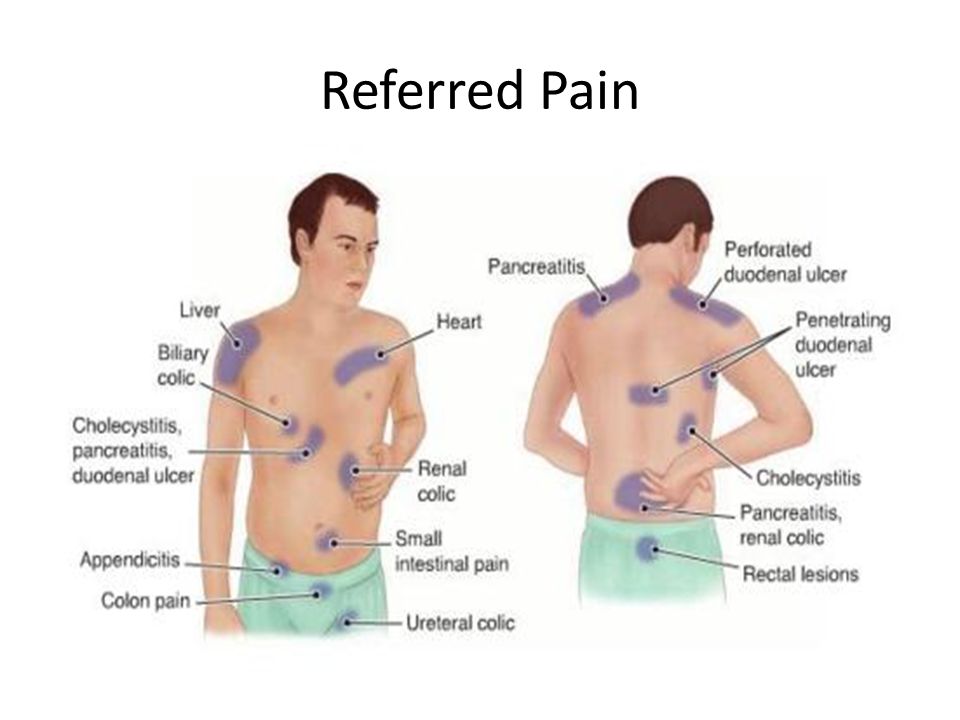 pylori, and smoking are the major risk factors. With the advent of PPIs (proton pump inhibitors) and the understanding of H. pylori, ulcers can usually be treated medically before they affect digestion. On a rare occasion, they may cause obstruction of the stomach, severe bleeding, or perforation of the intestine which may require surgery. In general though, the long term impact on digestion in minimal.
pylori, and smoking are the major risk factors. With the advent of PPIs (proton pump inhibitors) and the understanding of H. pylori, ulcers can usually be treated medically before they affect digestion. On a rare occasion, they may cause obstruction of the stomach, severe bleeding, or perforation of the intestine which may require surgery. In general though, the long term impact on digestion in minimal.
Albert Snow, ND (holisticgastroenterology.com)
First off, let’s not buy into the myth that ulcers are caused by a bacteria called H. pylori. Just not true. Ulcers are caused by the prior use of a medication that destroyed your mucosal lining, thus leaving your stomach tissue exposed to your own digestive acids, which then eat a hole right through the flesh. This is also true of ulcerative colitis. Ulcers don’t impact digestion, but in this scenario digestion impacts the ulcer (creating it).
William Chey, MD (med.umich.edu)
For many years, ulcers were thought to be due to stress or excess amounts of stomach acid.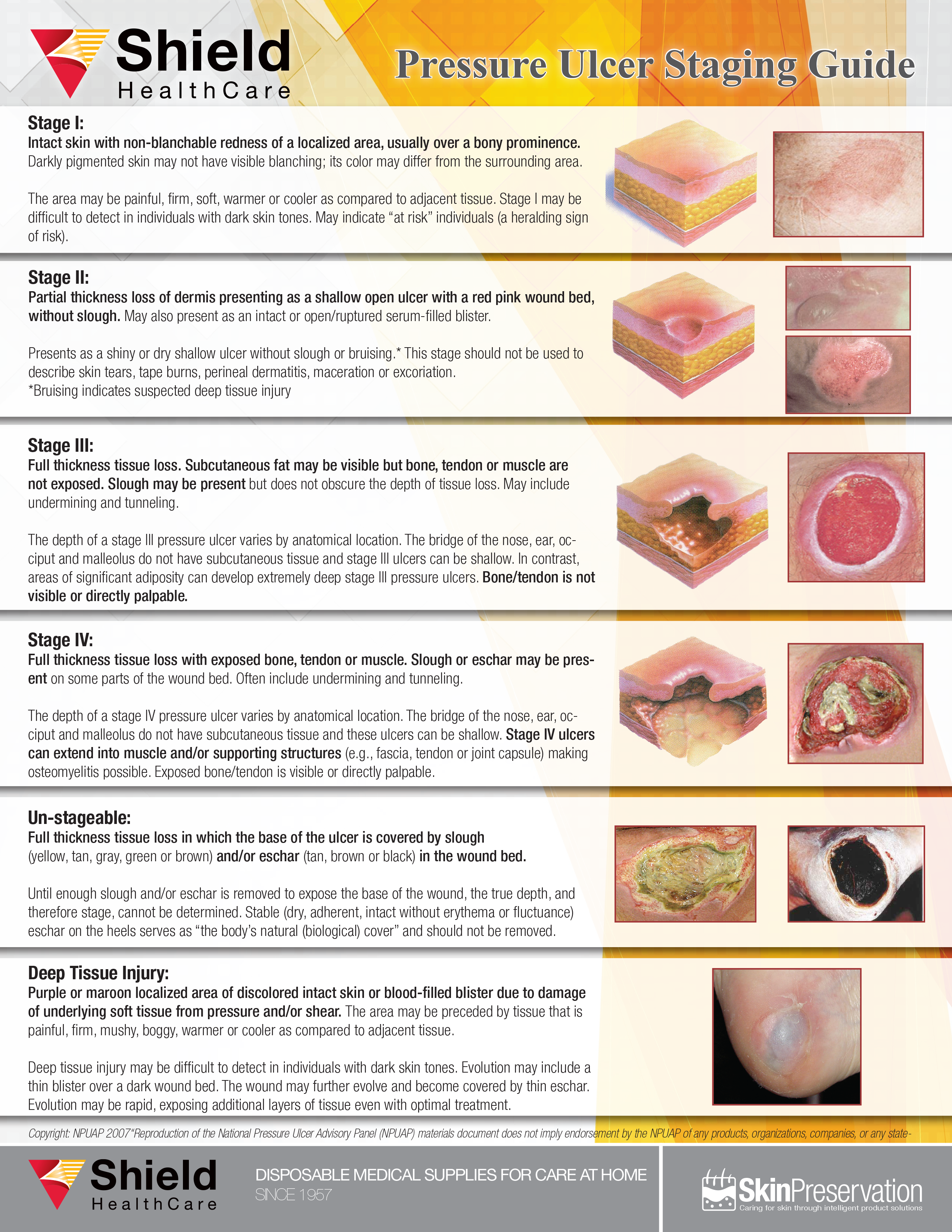 As it turns out, the most common causes of gastic (stomach) and duodenal (first part of the small intestine) ulcers are a specific type of bacteria called Helicobacter pylori and medications, most notably, nonsteroidal anti — inflammatory drugs (NSAIDs) and aspirin. Any person found to have an ulcer should be tested for H. pylori infection and asked about the use of these medications. H. pylori can be tested for using a breath test, by stool testing, or by checking for the bacteria in biopsy specimens from the stomach. This organism is usually treated with a combination of 3 to 4 antibiotics for 10 to 14 days. Curing the infection leads to healing of the ulcer and significantly reduces the likelihood of getting recurrent ulcers. Ulcers related to the use of NSAIDs or aspirin are typically healed with drugs that potently suppress the production of stomach acid called the proton pump inhibitors (PPIs). If a person can discontinue their NSAID or aspirin, a 10 — to 12 — week course of PPI therapy is sufficient to heal the ulcer.
As it turns out, the most common causes of gastic (stomach) and duodenal (first part of the small intestine) ulcers are a specific type of bacteria called Helicobacter pylori and medications, most notably, nonsteroidal anti — inflammatory drugs (NSAIDs) and aspirin. Any person found to have an ulcer should be tested for H. pylori infection and asked about the use of these medications. H. pylori can be tested for using a breath test, by stool testing, or by checking for the bacteria in biopsy specimens from the stomach. This organism is usually treated with a combination of 3 to 4 antibiotics for 10 to 14 days. Curing the infection leads to healing of the ulcer and significantly reduces the likelihood of getting recurrent ulcers. Ulcers related to the use of NSAIDs or aspirin are typically healed with drugs that potently suppress the production of stomach acid called the proton pump inhibitors (PPIs). If a person can discontinue their NSAID or aspirin, a 10 — to 12 — week course of PPI therapy is sufficient to heal the ulcer. If a person needs to stay on an NSAID or aspirin, PPI therapy should be continued to reduce the risk of developing another ulcer.
If a person needs to stay on an NSAID or aspirin, PPI therapy should be continued to reduce the risk of developing another ulcer.
Jacqueline Wolf, MD (drjacquelinewolf.com)
Stomach and duodenal ulcers are usually due to one of two causes: the bacterium Helicobacter pylori or nonsteroidal anti — inflammatory drugs (NSAIDs) like aspirin, ibuprofen, and naproxen. An ulcer, regardless of the cause, can cause abdominal pain, bleeding, or even cause a hole (perforation). An ulcer is maintained by an acid environment in the stomach and pepsin, which is produced in the stomach. Chronic infection with H. pylori causes an increase in acid. There is also a change in some of the cells in the duodenum that is created by the acid change called gastric metaplasia. Additionally the bacteria create an active immune response that could contribute to ulcer formation/inflammation and they appear to decrease the response of protective factors in the lining of the stomach and duodenum.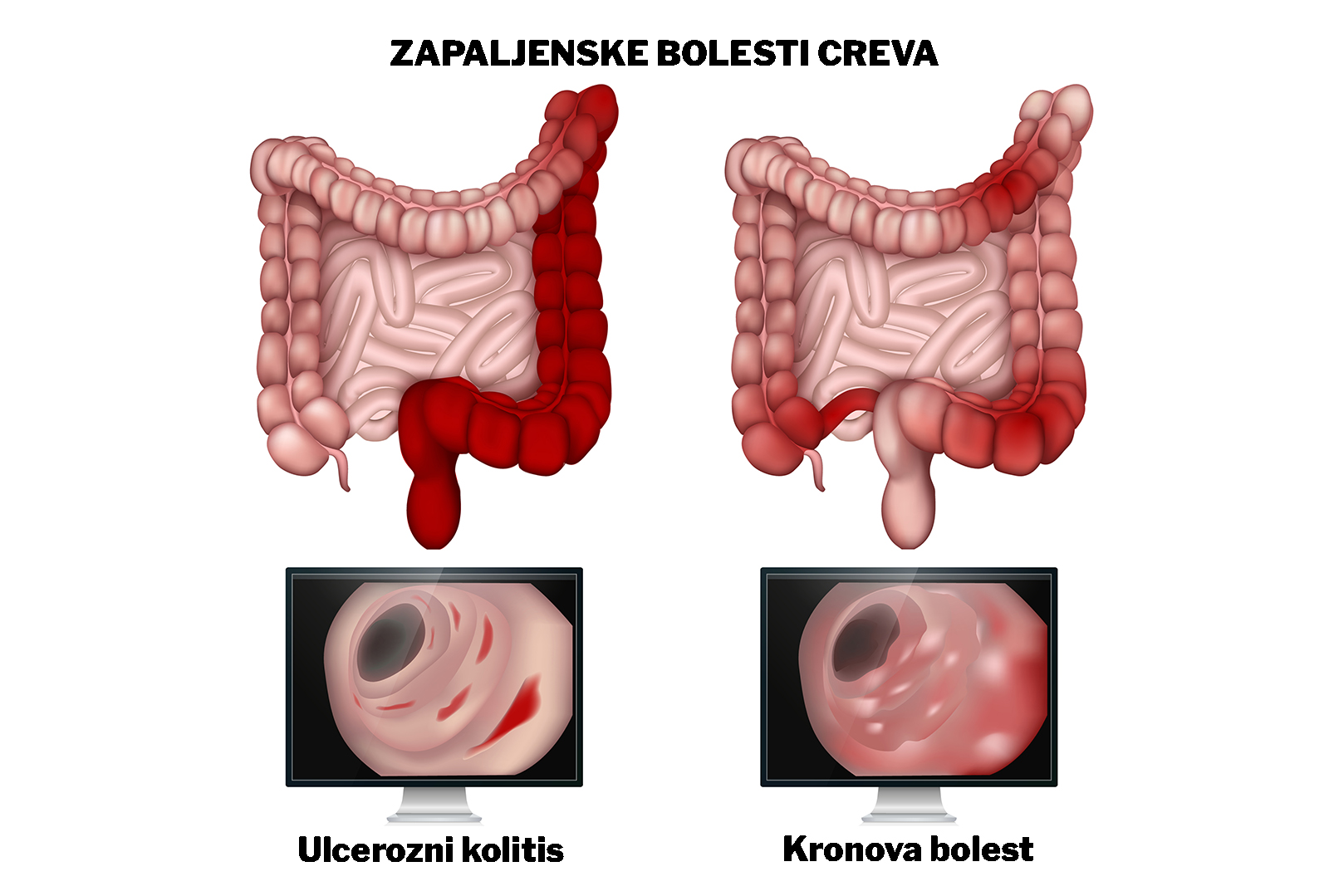 Smoking also increases ulcer formation. NSAIDs, by their effect on prostaglandins, can increase stomach acid, decrease the substances that protect the lining like bicarbonate and glutathione, and can allow the hydrogen ions to diffuse (go) backwards into the stomach lining and decrease the rate of blood flow to the stomach lining.
Smoking also increases ulcer formation. NSAIDs, by their effect on prostaglandins, can increase stomach acid, decrease the substances that protect the lining like bicarbonate and glutathione, and can allow the hydrogen ions to diffuse (go) backwards into the stomach lining and decrease the rate of blood flow to the stomach lining.
Peptic ulcers – MyDr.com.au
What is a peptic ulcer?
A peptic ulcer is a lesion or sore on the protective lining of the stomach (where it is called a gastric ulcer) or duodenum. Doctors often define it as a mucosal break greater than 3-5 mm in the stomach or duodenum, with a visible depth.
Peptic ulcers are a common condition – they used to affect men more than women, but now their occurrence is similar in men and women.
Symptoms
Peptic ulcers do not always cause signs or symptoms, but some of the symptoms of peptic ulcer are:
- Upper abdominal pain. The usual symptom of an ulcer is pain in the upper part of the abdomen just below the breast bone.
 It is often a burning or ‘knife-like’ pain which goes through to the back. The pain generally occurs when the stomach is empty (a few hours after meals) and will often wake the sufferer at 2 or 3 o’clock in the morning. The pain is often relieved by food or antacid medication.
It is often a burning or ‘knife-like’ pain which goes through to the back. The pain generally occurs when the stomach is empty (a few hours after meals) and will often wake the sufferer at 2 or 3 o’clock in the morning. The pain is often relieved by food or antacid medication. - Heartburn may occur, although this is more often a symptom of gastro-oesophageal reflux
- Indigestion.
- Nausea (feeling sick).
- Loss of appetite.
- Unexplained weightloss.
- Anaemia may occur due to blood loss, which may happen slowly. Symptoms of anaemia include tiredness, shortness of breath with exercise, and pale skin colour.
- Vomiting blood. This is a more serious symptom that happens if the ulcer bleeds.
- Passing blood in the bowel motions. Also a serious symptom as a result of the ulcer bleeding. If this happens the motions have a black, ‘tar-like’ appearance.

- Perforation. On rare occasions an ulcer will perforate (form a hole) through the stomach or duodenal wall. This is a major emergency requiring surgery and may be life-threatening.
Risk factors for peptic ulcer
Ulcers are areas of damage to the lining of the stomach (gastric ulcer), or the upper part of the intestine (duodenal ulcer).
The 2 most common risk factors for peptic ulcer are Helicobacter pylori (a bacterium that lives in the stomach), and long term use of NSAIDs (non-steroidal anti-inflammatory drugs).
Helicobacter pylori
Many people with ulcers have an infection in the stomach with a bacterium known as Helicobacter pylori. H. pylori infection is particularly important in the development of duodenal ulcers. The bacteria cause ongoing inflammation of the stomach lining.
It is estimated that up to 4 of every 10 adults in the world are infected with Helicobacter pylori, but not every one of them will go on to develop an ulcer.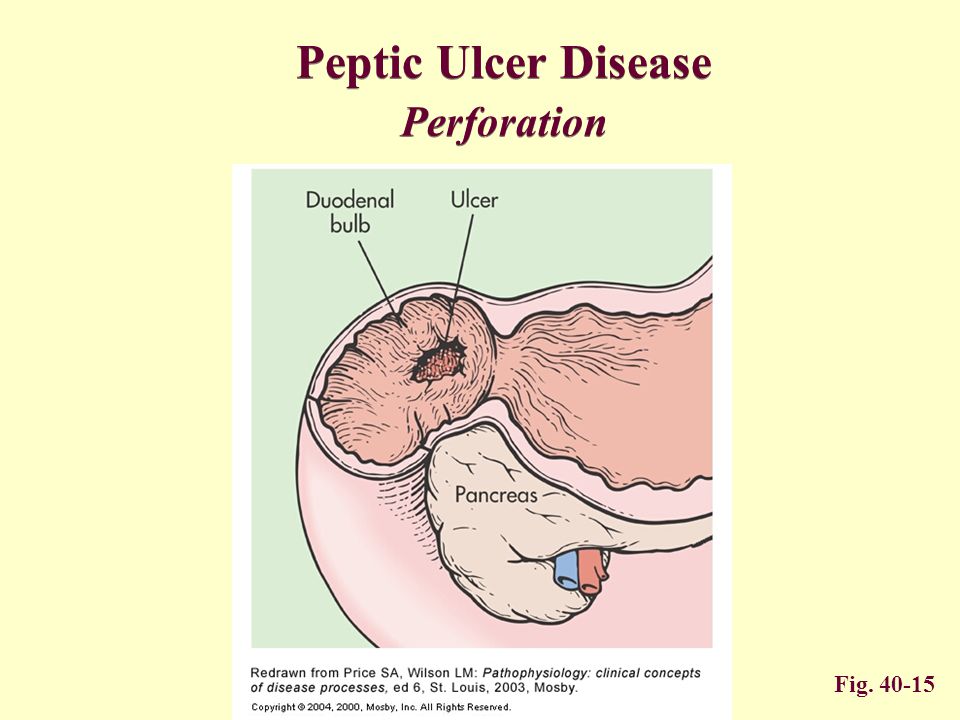 Thirty per cent of Australians are estimated to be infected, but infection rates are greater for Indigenous Australian communities. It’s not clear why some people with H. pylori seem to be resistant to developing ulcers.
Thirty per cent of Australians are estimated to be infected, but infection rates are greater for Indigenous Australian communities. It’s not clear why some people with H. pylori seem to be resistant to developing ulcers.
H. pylori is more common in older age groups. It is often acquired in childhood and the increased incidence in older people may reflect living conditions in earlier years, more than it does age.
NSAIDs
Long-term use of NSAIDs (non-steroidal anti-inflammatory drugs), such as aspirin, ibuprofen and naproxen, is linked to an increased risk of peptic ulcer. This is because most NSAIDs are associated with an increased risk of damage to the gastrointestinal mucosa.
Other factors
Other factors which additionally may increase the risk for peptic ulcers, and make them more difficult to treat, include smoking, alcohol and stress.
Tests and diagnosis
Your GP may refer you to a gastroenterologist for tests and treatments, depending on your symptoms, age and medical history.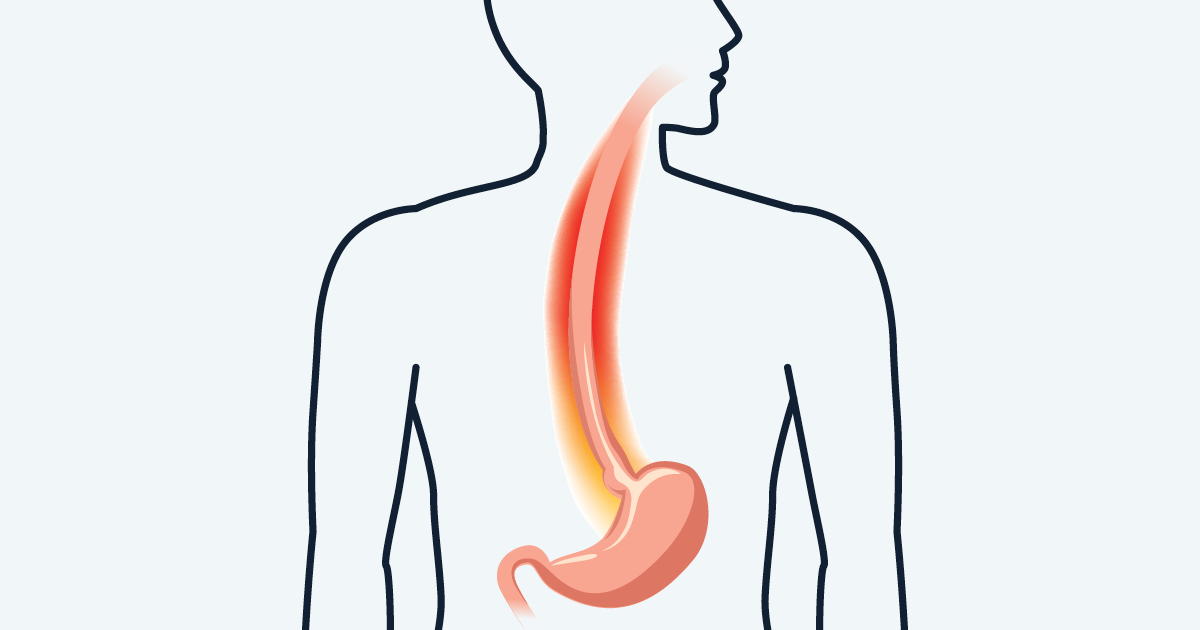
Peptic ulcers can be diagnosed by endoscopy, where a flexible telescopic tube is passed through your mouth down into the stomach and duodenum, allowing the doctor to examine the tissues. If they find an ulcer, they may take a small sample (biopsy) to test for H. pylori bacteria.
The doctor will probably also want to test you for H. pylori – usually by a breath test. H. pylori can also be tested for by a blood test or a stool test.
Treatment
Your doctor will probably suggest you take H. pylori eradication therapy. Eradication of H. pylori greatly reduces the likelihood of ulcers recurring and the need for long-term acid suppression therapy. Most ulcers respond well to this therapy.
Eradication of H. pylori takes the form of triple therapy – a proton pump inhibitor (esomeprazole) and the 2 antibiotics amoxicillin and clarithromycin – taken for a week. Examples of brand names of triple therapy are Esomeprazole Sandoz Hp7 and Nexium Hp7.
The proton-pump inhibitor suppresses acid production in the stomach and allows healing to take place.
There are alternative medicines for people allergic to penicillin.
Triple therapy will heal most active peptic ulcers and eradicate H. pylori in 70-80 per cent of cases. Some more complicated ulcers will also need a short maintenance course of a proton-pump inhibitor until the ulcer is confirmed to be healed.
People with NSAID-induced ulcers should ideally stop taking the NSAIDs (on their doctor’s advice). If this is not possible, they may need to take a proton-pump inhibitor also for a prolonged time to suppress excess acid production in the stomach.
People whose ulcers are linked to H. pylori should also stop taking NSAIDs if they can. But always check with your doctor.
Very rarely, peptic ulcers cause complications, and surgery is necessary to stop bleeding.
What should you do if you have ulcer symptoms?
If you have symptoms suggestive of a peptic ulcer, see the doctor.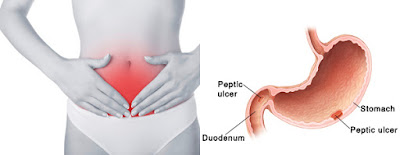
This common condition is easily managed and serious complications are usually preventable.
1. Therapeutic Guidelines (eTG). Helicobacter pylori and peptic ulcer disease.. In: Gastroenterology Guidelines [updated 2006, Sep; accessed 2009, Oct 2]. Available from: http://www.etg.hcn.net.au/
2. Ford A, McNulty C, Delaney B, Moayyedi P. Helicobacter pylori infection. BMJ Clinical Evidence 2007; 06:406
Stomach Ulcers: Causes, Symptoms & Treatments
Peptic ulcers, also known as stomach ulcers, are open sores that develop in the lining of the esophagus, stomach or the first part of the small intestine, known as the duodenum. Over 25 million Americans will suffer from an ulcer at some point during their lifetime, according to the Centers for Disease Control and Prevention (CDC), and there are approximately 500,000 to 850,000 new cases of ulcer disease each year.
Most ulcers are caused by an infection by Helicobacter pylori bacteria (H. pylori), and can be treated in about two weeks with antibiotics, according to the CDC.
pylori), and can be treated in about two weeks with antibiotics, according to the CDC.
“The two most common causes of ulcers are H. pylori, a bacterial infection, and medications, most commonly aspirin and other non-steroidal anti-inflammatory medicines (NSAIDs), and iron tablets,” said Dr. Arun Swaminath, director of the Inflammatory Bowel Disease Program at Lenox Hill Hospital in New York City.
The discovery of H. pylori‘s role in ulcers led to the Nobel Prize in 2005 for Barry Marshall and Robin Warren, who were ridiculed when they suggested the idea, Swaminath said. It is a myth that peptic ulcers are caused by stress and spicy food. But these factors make someone who already has ulcers feel even worse.
“Psychological stress probably has no role in the development of ulcers, though biological stress like being a very ill patient in the intensive care unit can definitely contribute to ulcers,” Swaminath said. “Foods aren’t really thought to contribute to ulcers, but they may make patients with already present inflammation or ulcers feel worse depending on what’s eaten,” he said.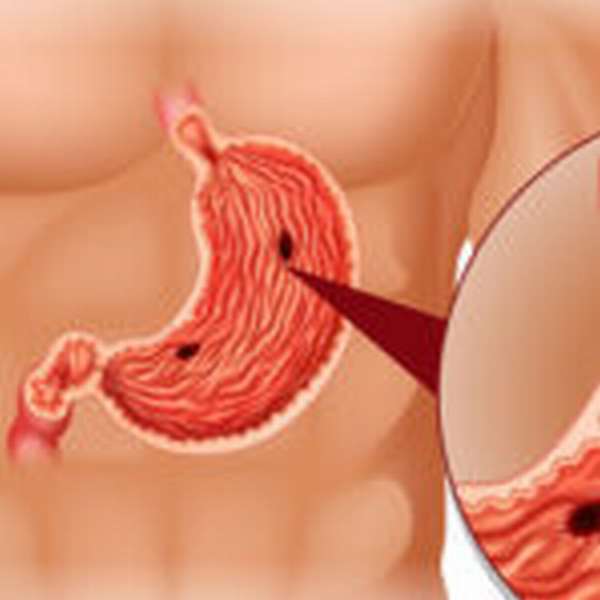
Symptoms
The most common symptom of peptic ulcers is a burning pain in the stomach, according to the National Institutes of Health (NIH). Typically, the pain starts between meals or during the night, and may stop if you eat or take antacid medications. The pain comes and goes for several days or weeks, and can be felt anywhere from your navel up to your breastbone, according to Mayo Clinic.
Although the most common symptom of ulcers is pain, the condition can also present as bleeding or anemia, Swaminath said. “There are a lot of other organs around the area of the stomach. Part of the challenge of figuring out what is causing the ‘abdominal pain’ is to rule in or out things like: pancreatitis, gallstones, Crohn’s disease, or stomach cancer.”
Psychological stress can cause symptoms that mimic the symptoms of ulcers, Swaminath said. But because stressed-out people are at the same risk for factors that really can result in ulcers, they should consult their doctor if they have persistent symptoms, he said.
Causes
Peptic ulcers happen when the acids that help digest food damage the walls of the stomach or duodenum. The insides of the digestive tract are coated with a mucus layer that protects against stomach acid, but in some people who are infected with H. pylori, the bacteria get into the mucosal lining in the stomach, creating holes and exposing more sensitive tissue to stomach acid.
H. pylori is a common infection, and it is possible that the bacteria is spread between people through contact with infected stool, vomit or saliva. It also may be contracted from contaminated water or food. According to the Mayo Clinic, one in five young adults is actually infected with the bacteria. Still, for unknown reasons it does not result in ulcers in everyone.
Another cause is the regular use of certain pain relievers, specifically, non-steroidal anti-inflammatory drugs (NSAIDS) such as aspirin and ibuprofen (Advil). The CDC states that 10 percent of ulcers are caused by NSAIDs.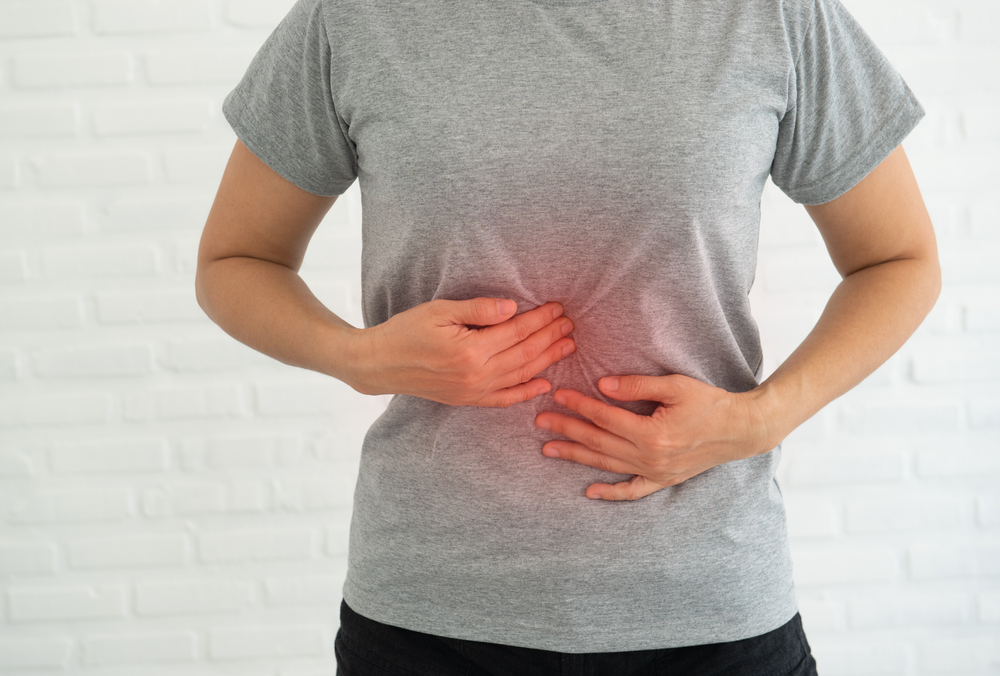 These medications, as well as naproxen (Aleve) and ketoprofen, can irritate or inflame the lining of the stomach and small intestine. Peptic ulcers are more common in older adults who take these pain medications frequently or in people who take these medications for osteoarthritis.
These medications, as well as naproxen (Aleve) and ketoprofen, can irritate or inflame the lining of the stomach and small intestine. Peptic ulcers are more common in older adults who take these pain medications frequently or in people who take these medications for osteoarthritis.
Cigarettes, alcohol, and stress can exacerbate symptoms by further irritating the stomach lining.
If left untreated, stomach ulcers can cause bleeding from the ulcer that can lead to anemia. The bleeding can show up as black colored stool, Swaminath said.
Diagnosis & tests
Doctors most commonly diagnose ulcers using endoscopy, Swaminath said. This involves “taking a camera directly into the stomach to look for ulcers and taking biopsies to make sure the ‘ulcers’ aren’t really cancer or something else,” he said.
There are several other tests for the diagnosis of stomach ulcers. A physician may use a blood, stool, or breath test to detect the presence of H. pylori or antibodies to H. pylori, according to the Mayo Clinic.
pylori, according to the Mayo Clinic.
A breath test consists of drinking a glass of liquid that contains a radioactive substance. This substance reacts with H. pylori so that when an individual with stomach ulcers blows into a bag, the breath will contain the radioactive carbon in the form of carbon dioxide.
Sometimes an X-ray exam may be performed to visualize the ulcer. A liquid containing a metal element called barium is ingested for this procedure. If an ulcer is found, the physician may look inside the digestive tract with endoscope, a flexible tube with a camera and light attached.
Treatment & Medication
Treatment of stomach ulcers consists of killing H. pylori and decreasing the amount of acid in the stomach. This requires several types of medications.
Physicians may prescribe several antibiotics at once, or use a combination drug such as Helidac to kill H. pylori. Helidac contains two antibiotics along with an acid-reducing drug and a medication that protects stomach tissue.
The doctors will also try to stop other medications the patient is taking and might have a role in worsening the ulcers.
“Most of the time, we try to withdraw the offending medication, but that is not always possible, for example patients on aspirin who have heart arrhythmias, or recent heart stents,” Swaminath said.
“We put patients on high doses of the drug for eight weeks by which time the area will typically heal,” Swaminath said. “A low dose is continued indefinitely if the offending medication can’t be discontinued.”
Drugs called acid blockers (for example, Pepcid) and antacids may be recommended to decrease the levels of stomach acid. Other medicines, called proton pump inhibitors, such as Prilosec and Prevacid, are another option. They work by blocking cellular pumps that release acid into the stomach.
Additional reporting by Alina Bradford, Live Science contributor.
Additional resources
How to Recognize Stomach Ulcers
For people who suffer from them, ulcers in the stomach are a painful and constant issue. Also known as peptic ulcer disease, these are sores that develop inside your stomach. Ulcers may cause severe pain at best, but at worst they create much more serious issues in the stomach.
Also known as peptic ulcer disease, these are sores that develop inside your stomach. Ulcers may cause severe pain at best, but at worst they create much more serious issues in the stomach.
In a lot of cases, recognizing and identifying ulcers as the source of your pain can be a big first step. Many people try to push through their stomach pain, or convince themselves it’s caused by another, less serious factor.
Without treatment, though, stomach ulcers can become serious. With that in mind, let’s look at a few basic tips for identifying peptic ulcer disease.
Symptoms
There are a few other common symptoms for many cases of stomach ulcers including:
- Bloating or gassiness, including frequent belching
- Nausea
- Heartburn
- Trouble eating fatty foods
In some cases, especially when left untreated, ulcers can have even worse symptoms. These can include:
- Large changes in appetite, including unexpected weight loss
- Difficulty breathing
- Vomiting, especially vomiting blood
- Blood or dark material in stools
- Sharp, severe pain
Roughly 75 percent of all cases of stomach ulcers show no symptoms at all.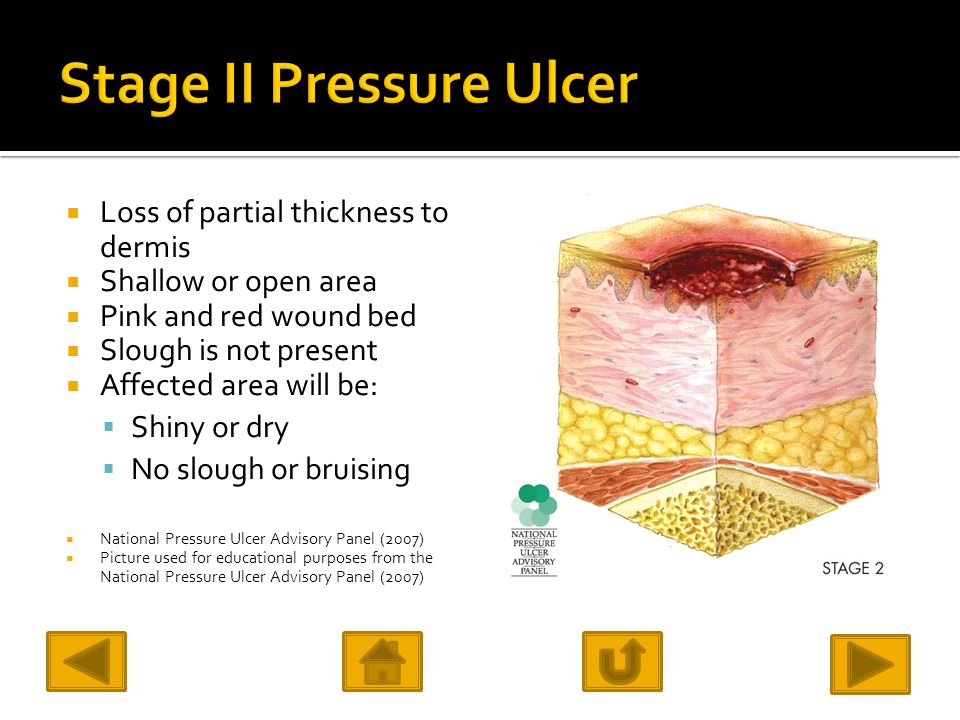 In many cases this means the condition isn’t serious enough to worry about, but in others it could mean the ulcers continue to get worse while nothing is done.
In many cases this means the condition isn’t serious enough to worry about, but in others it could mean the ulcers continue to get worse while nothing is done.
Risk Factors
Many people are at a higher risk than normal for stomach ulcers, and these people should pay close attention to ulcer symptoms. These groups can include:
- People who smoke or drink alcohol regularly
- People who regularly use painkillers like aspirin or ibuprofen
- People who produce high amounts of acid in their bodies
- People who have had radiation treatment
- People who eat a lot of spicy food or have a lot of daily stress
If you fit into any of these categories, you should be on higher alert for any stomach ulcer symptoms mentioned above. If any symptoms come up, talk to your doctor right away.
Tests
Your doctor will be able to identify most stomach ulcers with pretty solid accuracy based on your symptoms, but there are times where certain tests are needed. These tests will depend on all the specifics of each individual case. Some types of tests available for stomach ulcers include:
These tests will depend on all the specifics of each individual case. Some types of tests available for stomach ulcers include:
Basic Lab Tests: A bacteria called H. pylori (Helicobacter pylori) cause most cases of stomach ulcers, and the simplest way to identify many of these cases is figuring out whether this bacteria is present in the body or not.
- Breath test: Involves eating an item filled with radioactive carbon, which is broken down by the stomach. You’ll then blow into a bag – if carbon dioxide is present, it means you’re infected with H. pylori.
- Stool test
- Blood test: Not typically used, as results are not always accurate.
Endoscopy: If your doctor still isn’t sure, he or she might recommend an endoscopy, or a scope of the digestive system. Your doctor will feed a lens attached to a small tube down the throat and into the digestive system to manually check for stomach ulcers.
X-rays: Referred to in the medical community as an upper gastrointestinal series or a barium swallow, this test is a group of X-rays taken of the upper digestive system.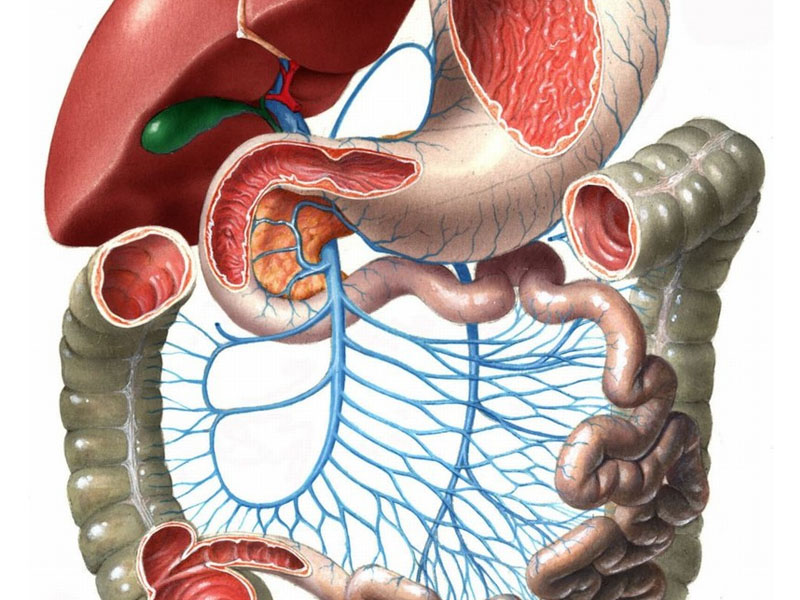 You will swallow a liquid containing barium, a contrast agent meant to make its way into your digestive system and help make potential ulcers easier to see.
You will swallow a liquid containing barium, a contrast agent meant to make its way into your digestive system and help make potential ulcers easier to see.
In some minor cases, your doctor may recommend taking a heartburn or other anti-acid medication to see if it helps with symptoms before further testing. In cases where these tests do identify active ulcers, though, treatment usually begins immediately.
Our Utah family medicine providers are trained in a broad range of disciplines including internal medicine, pediatrics, obstetrics and gynecology and geriatrics.
Sources:
“What Is Peptic Ulcer Disease?” WebMD. http://www.webmd.com/digestive-disorders/digestive-diseases-peptic-ulcer-disease#1
“Peptic ulcer.” The Mayo Clinic. http://www.mayoclinic.org/diseases-conditions/peptic-ulcer/home/ovc-20231363
90,000 Peptic ulcer disease: familiar and so many-sided
Peptic ulcer – a chronic cyclically recurrent polyetiologic disease, the main morphological substrate of which is an ulcer defect and / or a scar within the gastroduodenal zone, manifested mainly by abdominal pain syndrome and gastric dyspepsia syndrome.
Exacerbation of the disease: with the localization of ulcers in the cardiac and subcardial parts of the stomach – early pain, with ulcers of the antrum, pyloric canal and duodenum – late pain, as well as “hungry” and “night”.Appetite usually does not decrease, and often even increases, especially with duodenal ulcer localization (“painful feeling of hunger”). The general condition of patients worsens, there is increased fatigue, weakness, sweating, disability, depression or, on the contrary, excitement is observed. Pain syndrome can be typical (pains are characterized by rhythm and frequency of occurrence, often appear at a strictly defined time for a given patient – a symptom of an alarm clock) and atypical.Pain in the epigastric region is the most characteristic clinical symptom of peptic ulcer disease. Early – pains that appear in the first 1 – 1.5 hours after eating. Late – pain that appears 2 – 5 hours after eating. Hungry – pains that, occurring a few hours after eating, quietly disappear or weaken after a new meal. Night – pains that occur at night and cause the patient to awaken. Early pain often suggests concomitant esophagitis. There is some peculiarity of the pain syndrome.Pain of a constant nature – the interest of the pancreas. The paroxysmal nature of the pain is the interest of the gallbladder. Combination with symptoms of gastric dyspepsia (nausea, vomiting) – there is a noticeable violation of gastric evacuation of functional or organic origin.
Night – pains that occur at night and cause the patient to awaken. Early pain often suggests concomitant esophagitis. There is some peculiarity of the pain syndrome.Pain of a constant nature – the interest of the pancreas. The paroxysmal nature of the pain is the interest of the gallbladder. Combination with symptoms of gastric dyspepsia (nausea, vomiting) – there is a noticeable violation of gastric evacuation of functional or organic origin.
The following types of pain syndrome in peptic ulcer disease can be distinguished:
Visceral – dull pain, pressing, aching, relieved by eating, antacids, pronounced periodicity, uncertain localization in the epigastrium, do not radiate, symptoms of peritoneal irritation, local muscle tension on superficial palpation, tension of the anterior abdominal wall and skin hyperesthesia are absent, but present local soreness at the site of the affected organ with deep palpation, which does not coincide with the subjective localization of pain;
Visceral pain syndrome with irradiation – dull pain, diffuse, at the height of the pain is acute, can be stopped by eating, antacids, pronounced periodicity, irradiation is characteristic, Mendel’s symptom is positive, more often only when the ulcer is localized on the anterior wall, there is local muscle tension on superficial palpation , there is no tension in the anterior abdominal wall, skin hyperesthesia in the Zakharyin-Ged zones, local soreness at the site of the affected organ during deep palpation, which usually coincides with the subjective localization of pain;
Visceral-somatic pain syndrome – acute pains, cannot be stopped by eating, antacids, no periodicity, pronounced irradiation is characteristic, point pain in the area of the affected organ, Mendel’s symptom is positive, there is local muscle tension during superficial palpation, there is no tension in the anterior abdominal wall, cutaneous hyperesthesia at the site of ulcer localization and local soreness at the site of the affected organ with deep palpation, which coincides with the subjective localization of pain;
Somatic pain syndrome with perforation into the free abdominal cavity – sharp pain, “dagger”, diffuse, no periodicity, irradiation, point pain in the area of the affected organ, positive symptoms of Mendel, Shchetkin-Blumberg, diffuse pain of the anterior abdominal wall, anterior abdominal wall tense, there is diffuse cutaneous hyperesthesia at the site of the ulcer and local soreness at the site of the affected organ with deep palpation, which coincides with the subjective localization of pain.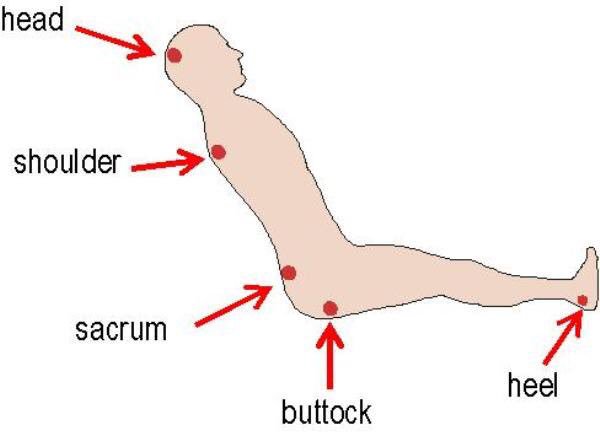
Atypical pain syndrome in peptic ulcer disease: cholecyst-like pain syndrome – right subcostal localization of pain, more often characteristic of women, with one or another interest in the gallbladder; retrosternal pain, as in angina pectoris, aggravated by physical exertion (with “high” ulcers and in the presence of perivisceritis with the formation of an adhesive process), however, unlike true angina pectoris, they are provoked or reduced after eating; pain in the region of the heart (when the ulcer is localized along the greater curvature of the stomach), appearing 30-40 minutes after eating and removed by eating, antacids, etc.e. Cramping pains, reminiscent of attacks of hepatic or renal colic, occurring acutely and periodically, regardless of food intake and its nature. Pain localized in the umbilical region and slightly below it, reminiscent of the clinic of intestinal colic, appendicitis and other diseases of the abdominal organs, which are often the cause of diagnostic errors up to appendectomy. Ossalgic variant – irradiation of back pain (left or right scapula, interscapular space, thoracic spine).
Ossalgic variant – irradiation of back pain (left or right scapula, interscapular space, thoracic spine).
Gastric dyspepsia syndrome: heartburn, belching (food, sour, air), changes in appetite (fear of eating with stomach ulcers due to provoking pain syndrome, frequent food intake for duodenal ulcers to relieve pain), nausea and vomiting (hypertension n.vagus: hypersecretion, dysmotility and spasm of smooth muscles, including the pylorus), inflammatory edema of the mucous membrane or cicatricial deformity of the pylorus and duodenal bulb, nausea precedes vomiting, vomiting sour, brings relief, a feeling of heaviness, fullness in the epigastrium (equivalent pain syndrome, with motor-evacuation disorders).
Intestinal dyspepsia syndrome. Constipation (more typical for duodenal ulcers): vagotonia (peristalsis, sphincter tone), dietary restrictions (fiber), medication (aluminum, bismuth). Diarrhea (more typical for stomach ulcers): against the background of hypochlorhydria, impaired bile secretion, dysfunction of the pancreas, the effect of eradication therapy.
Astheno-vegetative syndrome: general weakness, increased fatigue, emotional lability.It is necessary to exclude complications: bleeding, anemia, electrolyte disturbances with frequent vomiting, malignancy.
Clinical variants of peptic ulcer
Subcardial ulcers: age – 40-60 years, mild and atypical pain syndrome, burning sensation, pressure under the xiphoid process, irradiation behind the sternum, in the region of the heart, early pain (including during meals), insufficiency of cardiac pulp … Diagnostic difficulties, cardiac masks, left-sided pleurisy.High complication rate.
Ulcers of the body of the stomach: Average age, polymorphic clinical picture, moderate pain syndrome, early pain, to the left of the midline, nausea, belching, less often – heartburn, vomiting. Complications: bleeding 15%, often massive, perforation – 4%, malignancy – 8-10%, pay attention to ulcers along the greater curvature of the stomach!
Ulcers of the antrum: young and middle age, clinically similar to a duodenal ulcer, late pain, heartburn, belching, vomiting, bleeding 10-15%.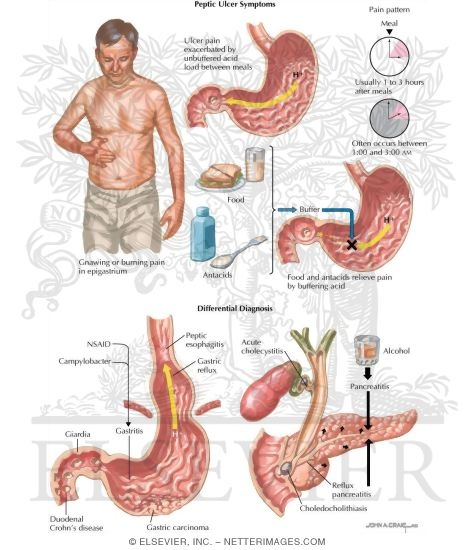
Pylorus canal ulcers: Intense pain syndrome, late pain, paroxysmal, irradiation to the back, persistent nausea and vomiting, a feeling of fullness, fast saturation, difficulties in X-ray diagnostics, malignancy 3-8%.
Ulcers of the duodenal bulb: young and middle age, hereditary history, hypersecretion of HCl, pain syndrome, late and night pains, heartburn, vomiting of acidic contents, brings relief, cyclicity and seasonality of the course, interest of the pancreas when localized on the medial wall.
Postbulbar ulcers: persistent, prolonged course, frequent recurrence, prolonged exacerbations, often multiple, hypersecretion of HCl, persistent pain syndrome, late (after 3-4 hours) and night pains, do not stop immediately, localized in the navel, heartburn, frequent bleeding, lesions of the Vater papilla, it is necessary to exclude symptomatic ulcers, including gastrinoma. In adolescence: duodenal localization, beginning with dyspeptic syndrome, vomiting, reflex nausea, weight loss, pallor of the skin, autonomic imbalance (red dermographism, sweating, hypotension, bradycardia, constipation, low-grade fever), hypovitaminosis, more often in the form of “mono -pathology “, rare involvement of neighboring organs in the pathological process, more often according to the variant of functional changes, often – the beginning with complications. In old age: often – oligosymptomatic and atypical course, against the background of concomitant pathology (vascular bed: HD, diabetes, coronary artery disease, respiratory system – hypoxia), taking ulcerogenic medications, multiple organ lesions of the gastrointestinal tract, the role of a trophic factor, high localization, large size , long-term scarring, frequent complications.
In old age: often – oligosymptomatic and atypical course, against the background of concomitant pathology (vascular bed: HD, diabetes, coronary artery disease, respiratory system – hypoxia), taking ulcerogenic medications, multiple organ lesions of the gastrointestinal tract, the role of a trophic factor, high localization, large size , long-term scarring, frequent complications.
Rare causes of peptic ulcer
Stomach ulcers:
adenocarcinoma, carcinoid, penetration of tumors of other organs, sarcoma, leiomyoma, foreign bodies, endocrine diseases, Crohn’s disease, syphilis, tuberculosis, HIV.
Duodenal ulcers: Zollinger-Ellison syndrome, chronic obstructive pulmonary disease, portal hypertension, Crohn’s disease, celiac disease, lymphoma, lesions, CNS trauma – Cushing’s ulcers, hypercalcemia, systemic mastoidosis, amyloidosis, polycythemia, HIV, HIV
Purpose of peptic ulcer treatment: to accelerate the scarring of the ulcer, quickly stop the clinical manifestations of the disease (pain, dyspeptic syndromes, etc.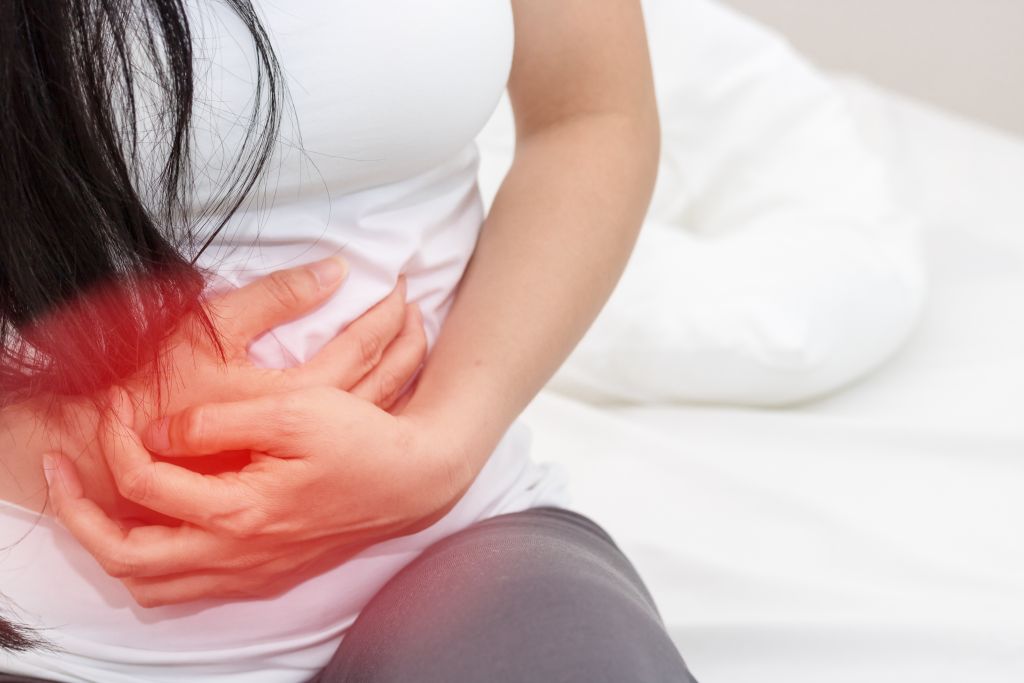 )and prevention of complications and ulcer recurrence.
)and prevention of complications and ulcer recurrence.
Stomach ulcer and 12-colon ulcer
Peptic ulcer of the stomach and duodenum is a chronic disease characterized by the formation of ulcers in the stomach and duodenum and proceeding with periods of exacerbation and remission.
From 5 to 15% of the adult population suffer from this pathology. According to statistics, duodenal ulcer is more common. It is noticed that in 60-75% of cases, stomach ulcers are associated with Helicobacter Pylori infection, and with duodenal ulcers – in 95%.Improper diet, long-term use of certain medications, adverse environmental influences can provoke the disease.
The main symptom of peptic ulcer disease is pain in the epigastrium (stomach area), most often associated with food intake. Pain can be on an empty stomach, the so-called “hungry” pains, night pains, occur immediately or 0.5-2 hours after eating. In many patients, pain radiates to the region of the heart, under the shoulder blades, to the thoracic spine.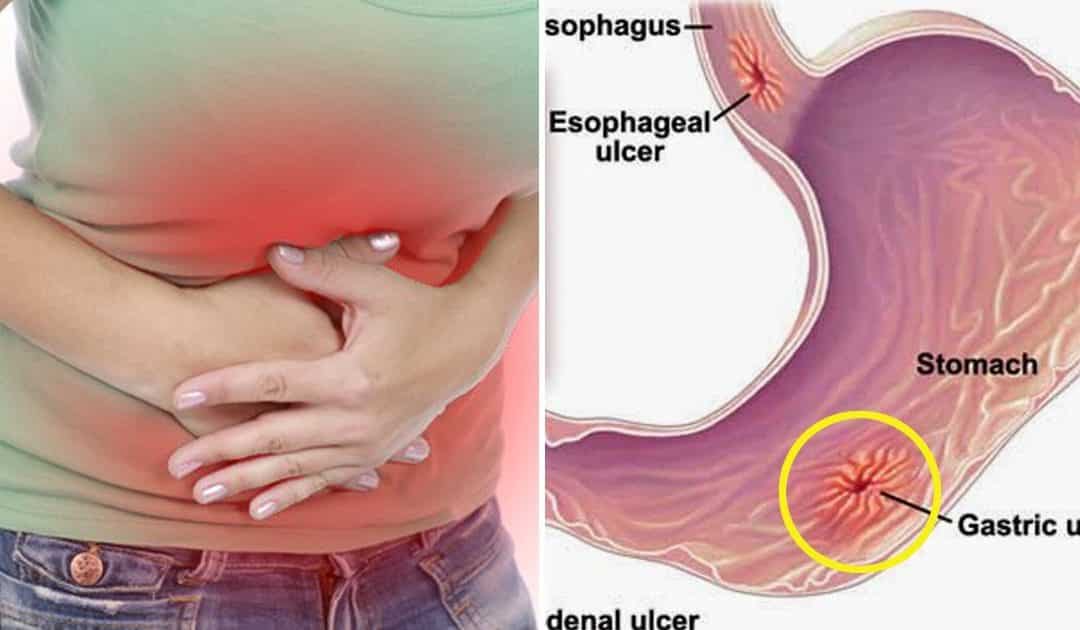 The body also gives other signals about an impending problem – heartburn, belching of air, nausea, vomiting become involuntary “companions” of the patient.
The body also gives other signals about an impending problem – heartburn, belching of air, nausea, vomiting become involuntary “companions” of the patient.
Peptic ulcer of the stomach and duodenum is dangerous for its complications. Gastrointestinal bleeding, perforation of the stomach wall, the degeneration of an ulcer into a malignant neoplasm of the stomach – these are the main complications of an ulcer that pose a threat to the patient’s life.
For the diagnosis of peptic ulcer, laboratory tests, esophagogastroduodenoscopy (FGDS) with biopsy and mandatory examination of the material for the presence of Helicobacter pylori infection are carried out. If necessary, additional examinations can be assigned.
Treatment of the disease should be timely and comprehensive. The patient is given recommendations for non-drug treatment (therapeutic regimen and medical nutrition) and prescribed drug therapy (eradication of Helicobacter Pylori, achieving stable remission and prevention of exacerbations).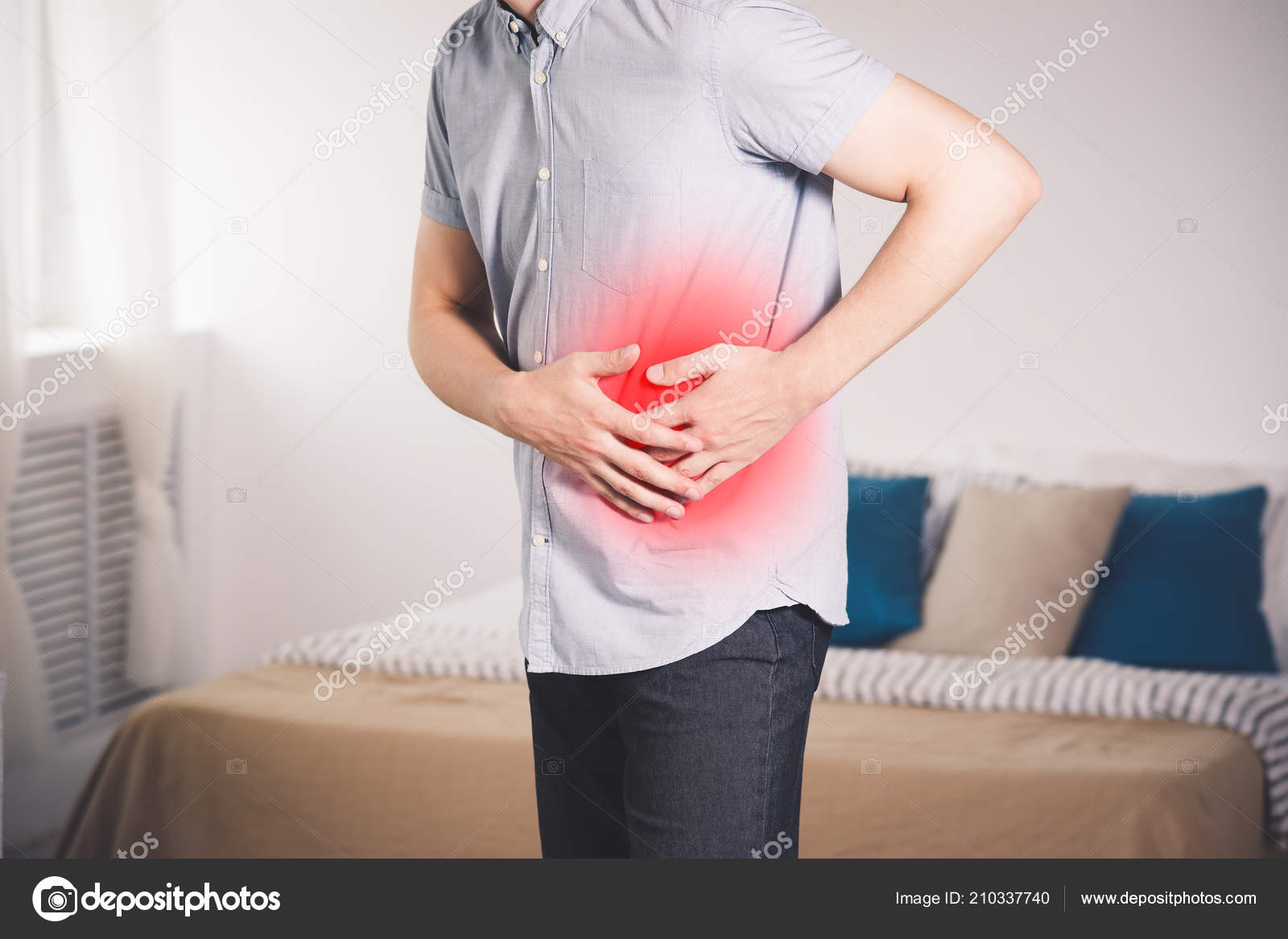 Physiotherapy and spa treatment have a beneficial effect on the course of the disease and help prevent relapse. Prescribing treatment regimens, selecting medications should be a qualified specialist individually for each patient, depending on the results of the examination.
Physiotherapy and spa treatment have a beneficial effect on the course of the disease and help prevent relapse. Prescribing treatment regimens, selecting medications should be a qualified specialist individually for each patient, depending on the results of the examination.
In cases of complications of peptic ulcer disease (bleeding from an ulcer with large blood loss, perforation of an ulcer, degeneration of an ulcer into stomach cancer, etc.), the patient may be offered surgical treatment.
SPECIALISTS
Malgina Tatiana Dmitrievna
Head of department, gastroenterologist
Bukhvalova Tamara Gennadievna
gastroenterologist of the first qualification category
90,000 Stomach ulcer – symptoms, diagnosis, treatment – Axis medical center (Zelenograd)
In the event of problems in the functioning of the digestive system under the influence of the increasing secretion of digestive juice, a decrease in the resistance of the mucous membrane, ulcerative lesions occur in the stomach and in the duodenum.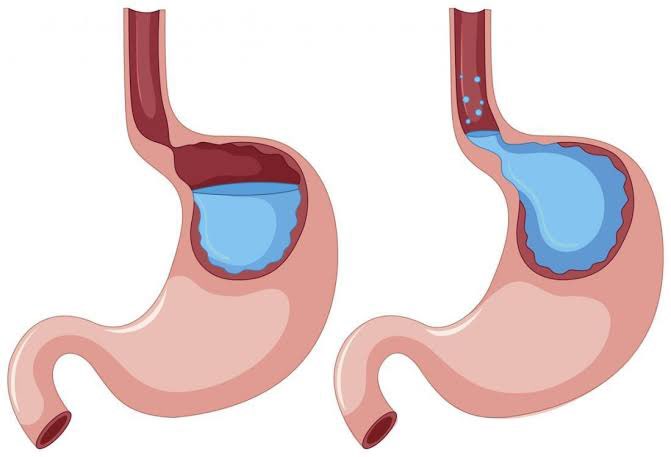 Pathology is accompanied by sharp pains, and with the progression of the disease, serious complications arise.
Pathology is accompanied by sharp pains, and with the progression of the disease, serious complications arise.
Causes of stomach ulcers
The reasons for the development of peptic ulcer disease in the stomach, small intestine and duodenum 12 are based on infection with a special bacterium called Helicobacter Pylori. The microbe is transmitted through close interaction between an infected and a healthy person. However, for the development of defects in mucous tissues, a combination of a number of other factors is required.
The precursor of stomach ulcers is gastritis and other diseases of the gastrointestinal tract, in which the acidity of gastric juice increases, and ulcer-provoking causes are:
- Frequent drinking
- Physical overvoltage
- Stressful situations
- Unbalanced nutrition
- Prevalence of spicy, salty foods in food
- Avitaminosis
- Blood clots in the vessels of the stomach
- Injuries in the gastrointestinal tract.

Treatment of stomach ulcers is prescribed after reliable identification of the combination of the causes of the disease. The factors causing the ulcer are distinguished:
- Stress ulcers are precursors of trauma, surgery, liver and kidney failure, and burn injuries.
- Medication – caused by medicinal ulcerogenic drugs, which include many anti-inflammatory drugs.
- Endocrine – are the result of disturbances in the functioning of the endocrine glands.
Chronic gastric ulcer is often the result of the onset and long-term development of diabetes mellitus, pancreatitis, liver cirrhosis.
Stomach ulcer symptoms
“If you experience similar symptoms, we recommend that you make an appointment with your doctor. You can also sign up by phone: +7 (499) 214-00-00
The symptoms of the disease are influenced by the age, size, location of the ulcer, and the presence of concomitant pathologies. Nevertheless, practice shows that there are general signs and characteristic symptoms of a stomach ulcer:
- Abdominal pain
- Heartburn, nausea, vomiting
- Flatulence, heaviness in the stomach
- Bloody inclusions in the feces.

Pain in stomach ulcers worsens especially after eating. Peptic ulcer disease is characterized by decreased appetite, thirst, and frequent belching.
A complicated form of pathology – perforated gastric ulcer – is characterized by intense, pronounced pain with a return to the sternum, back or collarbone. Within 4-6 hours, the pain becomes girdle, a temperature arises, dryness appears in the mouth, the integument begins to turn pale. At some point, the pain subsides for a while, but then comes back again.The condition is extremely dangerous and may be accompanied by tachycardia.
Diagnosis of the disease
The study draws attention to the nature of pain in stomach ulcers:
- With the formation of ulcerative pathology of the gastric mucosa, pain in humans begins within 15-30 minutes after eating.
- The duodenum reacts to prolonged lack of food, so pains appear on an empty stomach and at night.
The survey is carried out by conducting:
- FGS (gastroscopy), where samples of mucous tissues are taken around the zone of the ulcerative focus
- Contrast radiography, bacterial seeding
- Breath test
- Biochemical and> General blood test.

First of all, according to the analysis data, the presence of Helicobacter pylori bacteria on the walls of the gastric mucosa, small intestine and duodenum 12 is checked.
Stomach ulcer treatment
In the medical center of Zelenograd “AKSIS” an integrated approach is used in the appointment of a treatment program. Complex treatment of stomach ulcers allows you to quickly stop pain symptoms, eliminate relapses, exclude dangerous complications, which are often accompanied by bleeding, gastric perforation, and the development of malignant tumors.Perforated gastric ulcer is a dangerous complication characterized by the formation of a through hole (perforation) with the risk of developing peritonitis.
In addition to constant pain and the risks of the acute phase of the pathology developing into a chronic one, an exacerbation of a stomach ulcer causes a spasm of its walls – this is another serious complication in which food does not pass through the gastrointestinal tract.
Timely and fully carried out therapy allows you to eliminate the risks of complications, reduce acidity with special drugs and save a person from problems.Surgical treatment is used only in exceptional cases.
Prevention of gastric ulcer
Knowing the causes of the pathology, doctors have developed a number of measures to help prevent the development of peptic ulcer disease in the digestive tract. Among the recommendations, the most common tips are:
- Proper nutrition
- Stress Avoidance
- Timely treatment of gastrointestinal diseases
- Control of taking anti-inflammatory drugs
- Reducing drinking and smoking.
Diet for exacerbation of gastric ulcer
Diet food is a prerequisite for the prevention and treatment of ulcerative formations. The diet for stomach ulcers is based on the use of pureed, easily digestible food.
Stomach ulcer
Stomach ulcer is a chronic recurrent disease characterized by the presence of ulcerative defects in the gastric mucosa.
Peptic ulcer disease occurs with alternating periods of exacerbation and weakening of symptoms.The greatest number of exacerbations occurs during the off-season. In spring and autumn, the whole body is restructured, and it turns out to be especially vulnerable to external and internal factors, while even a slight decrease in immunity or emotional overload can lead to an exacerbation of peptic ulcer disease.
Along with the generally accepted causes of peptic ulcer disease, such as irregular diet, stress, smoking, alcohol abuse, hereditary predisposition, the activity of the harmful bacterium – Helicobacter pylori (Helicobacter pylori) is currently the leading place.
Alarming symptoms of peptic ulcer disease are pain in the epigastric region (between the lower part of the ribs and the navel) after eating, which are reduced as a result of taking special drugs to neutralize hydrochloric acid in the stomach, heartburn, nausea, belching, loss of appetite. But the diagnosis can be confirmed or refuted only after consultation with a doctor and visual examination of the stomach walls using special video equipment, carried out through the mouth and esophagus (gastroscopy). During this study, as a rule, a diagnosis is carried out for the presence of the bacterium Helicobacter pylori in the body.
In the off-season, peptic ulcer disease can make itself felt with such a formidable complication as bleeding from an open ulcer defect or the formation of a through hole in the stomach wall with spillage of hydrochloric acid and stomach contents into the abdominal cavity (perforation). Bleeding can proceed in different ways: sometimes it is vomiting of blood, and sometimes the appearance of severe weakness and black, like tar, stools.Perforation is accompanied by severe dagger pains in the stomach.
The main goal of the treatment of peptic ulcer disease is to reduce the release of hydrochloric acid and eliminate the main causes leading to ulceration. It is imperative to reduce the emotional stress. You can’t do without proper nutrition. To avoid exacerbations of peptic ulcer disease, try to eat regularly, 3-4 times a day, with the obligatory small meal in the evening. Do not overuse spices, hot sauces, fried, strong meat broths.If you have a peptic ulcer in the off-season, you should especially carefully monitor your health. After all, it is often combined with inflammation of the gallbladder, cholelithiasis, and intestinal diseases. An exacerbation of these concomitant diseases can exacerbate the ulcer itself.
If you have symptoms of peptic ulcer disease, you should immediately contact a specialist for examination and prescription of therapy.
Be healthy!
Doctors have discovered the cause of stomach ulcers – Rossiyskaya Gazeta
Peptic ulcer of the stomach and duodenal ulcer is the most common pathology among diseases of the gastrointestinal tract.And if earlier elderly men usually suffered from this ailment, today it increasingly affects young people and even children.
Scientist checked on himself
It turned out that the ulcer is an infectious disease, moreover, one of the most common on Earth. The bacterium that causes it is found in the stomachs of more than half of the world’s population. Its prevalence directly depends on the level of socio-economic development: in developed countries it is less (30-40%) than in third world countries, where almost everyone is susceptible to infection (up to 90%).The hereditary nature of the disease is also traced, while in each subsequent generation the disease begins at a younger age and progresses more severely.
Scientists in the 19th century suspected that gastritis and peptic ulcer disease are contagious, but it was only recently that the culprit was identified. In 1982, Australian researchers Barry Marshall and Robin Warren discovered the bacterium Helicobacter pylori and, after carefully studying its effects on the gastric mucosa, suggested that it causes peptic ulcer disease.To prove his theory, Barry Marshall even repeated the feat of Louis Pasteur and conducted an experiment on self-infection – he drank the culture of Helicobacter. Two weeks later, the young scientist fell ill with severe gastritis, and he recovered long and hard. But the bacterial nature of peptic ulcer disease has been proven.
Today, doctors say with confidence that 90% of all cases of duodenal ulcers and up to 80% of cases of stomach ulcers are caused by Helicobacter pylori. The remaining 10-20% are usually associated with long-term use of non-steroidal anti-inflammatory drugs such as aspirin or ibuprofen.Stress, spicy food, smoking, alcohol, carbonated drinks and other harmful factors only worsen the patient’s condition, but do not cause ulcers by themselves.
The discovery of Australian scientists radically changed the approach to treatment. Previously, the emphasis was on diet, now it is obvious that an ulcer is by no means a chronic ailment, but a disease that can be eliminated by taking antibiotics. As a result, even with advanced peptic ulcer disease, many patients manage to avoid surgery. The incidence of stomach cancer, which, as it turned out, is provoked by the same bacteria, has also decreased.
Evil Bacteria
The food that you ate enters the stomach through the esophagus, where it is mixed with gastric juice containing digestive enzymes and hydrochloric acid. Helicobacter – almost the only bacteria that gastric juice does not destroy – burrows into the gastric mucosa, disrupting the structure of its tissues and their functions. This potentially leads to inflammation of the stomach lining (gastritis), erosions and ulcers.
With weakened immunity and long-term existence in the body, Helicobacter pylori can spread both to the overlying parts of the stomach and to the duodenal bulb.
Pale, nervous, sad
This is a portrait of a person suffering from peptic ulcer disease. He is tormented by heartburn, nausea, sometimes vomiting, pain in the stomach. It can become aggravated in the intervals between meals, after meals – immediately or after 2-3 hours.
Most often, pains occur in the epigastric region, but can be given under the scapula, to the left side of the sternum (which is why they are often mistaken for heart pains), feel like a feeling of fullness in the stomach, heaviness in the stomach, or resemble a feeling of hunger.It is enough to drink sour juice, coffee, alcohol, take an aspirin tablet to worsen the pain. Antacids or food can help relieve discomfort. However, after a while, the torment resumes.
And since digestion is disturbed during peptic ulcer disease, the intestines also suffer. Eructations, heartburn begin. Due to poor assimilation of food, iron deficiency in the body and anemia (anemia) develop: a person feels constant fatigue, lethargy. Overall health weakens, immunity decreases.
Dangerous Kiss
The infection usually affects the lower part of the stomach already in early childhood and “lives” in it for many years. The main source of peptic ulcer disease is an infected person. You can get infected through everyday contact: it is believed that most often the infant receives the bacteria from an infected mother. It is possible that the bacterium enters the stomach through food and drink. You can catch Helicobacter through shared bedding, a towel, dishes, a handshake and a kiss. So be careful even with those with “mild gastritis”.In no case should you lick the spoons with which you interfere with the dishes. It is unacceptable to put baby pacifiers in your mouth.
Citizens suffer from stomach and duodenal ulcers 2 times more often than rural residents, and men (and often young) – 3-4 times more often than women. Smokers and drinkers are more at risk. As a rule, the ulcer worsens in the fall and spring, when immunity is impaired. Helicobacter, like other bacteria, prefers weakened people. Especially irritable: when a person is nervous, his stomach produces more hydrochloric acid than normal.And for the ulcerative bacillus, this is the most suitable environment. In it, it multiplies rapidly.
Don’t start!
Thanks to new approaches, 95% of cases of peptic ulcer disease are amenable to treatment, the number of complications such as ulcer perforation and ulcer bleeding is reduced by up to 10 times. Today, in the treatment of this ailment, in addition to antacid, astringent, enveloping, antispasmodic drugs, antibiotics and other medicines of the latest generation are used. It is necessary to take them in a course, without interruption, otherwise the bacterium will remain undefeated and the ulcer cannot be cured.Do not self-medicate!
In advanced forms, ulcers of large sizes can develop, which do not heal for a long time, and do not respond to conservative treatment. And then you need an operation to remove part of the stomach.
Unfortunately, our country has an unrepentant leading place in the world in terms of the number of operations for complicated peptic ulcer disease. This is due to the lack of a general sanitary culture of the population and a low standard of living. Our people often start the disease extremely, try to be treated with “grandmother’s means” and end up in the hospital in a very serious condition, when not just treatment is required, but saving their lives.
Diet is indispensable
In case of stomach ulcers, it is advisable to completely exclude certain foods from the diet. First of all … milk. Although it was once believed that a glass of milk was enough to relieve pain during an exacerbation of an ulcer. Alas, this was a misleading representation, because milk, as doctors found out, increases the amount of stomach acids, and does not neutralize them. In addition, any spicy and spicy food is included in the list of prohibited foods for stomach ulcers – it increases pain by irritating the tissues of already formed ulcers on the walls of the stomach.We’ll have to give up rich meat, mushroom, fish broths, fried, pickled, canned, sour foods and black bread. Coffee, alcohol and soda are also excluded – for their digestion, a large amount of stomach acids are needed, and their formation provokes the onset of peptic ulcer disease.
Smoking on an empty stomach is generally harmful, and with ulcers and gastritis it is simply dangerous. Chewing gum is no less harmful – especially on an empty stomach, it provokes the release of hydrochloric acid, gastric juice… But since the food has not arrived, the stomach will be busy digesting its own mucous membrane. Fasting is extremely harmful for the same reason. You need to eat a little, but 4-5 times a day. It is useful to drink a glass of mineral water half an hour before meals. Slimy broths help, especially jelly, porridge – oatmeal, rice.
Specifically
Who needs to be tested for Helicobacter pylori
Any of the following symptoms of “gastric malaise” should be the reason for visiting a gastroenterologist or therapist:
- recurring pain in the stomach, especially after eating (a sign of erosions and ulcers),
- the appearance or intensification of heartburn,
- a feeling of heaviness in the stomach,
- rejection of meat food (up to vomiting).
- And remember: 95% of peptic ulcer cases are treatable.
Perforated gastroduodenal ulcer – symptoms, modern methods of diagnosis and treatment
Perforation, or perforation, of stomach and duodenal ulcers is a breakthrough of an ulcer into the free abdominal cavity with the entry of gastro-duodenal contents into it. In 75% of cases, a perforated ulcer is located in the duodenum, more often observed in men aged 20-40 years with a short ulcerative history (up to 3 years).Sometimes ulcer perforation can occur in people who have never complained of epigastric pain and did not know about the presence of an ulcer. At a young age, perforation of duodenal ulcers prevails, and in the middle and elderly – gastric ulcers. Perforation of ulcers is more common in autumn and spring.
Sign up for a consultation before surgery
The first consultation is free!
Symptoms of perforation of the ulcer
The main complaint with perforation of an ulcer is pain in the upper abdomen.In most patients, perforation of stomach and duodenal ulcers begins suddenly, accompanied by sharp pains in the abdomen. The pains are so severe that patients compare them with a “dagger strike.” They are permanent, localized first in the epigastric region or in the right hypochondrium, and then spread relatively quickly throughout the abdomen, often along the right lateral canal. In 30-40% of patients, pain radiates to the shoulder, scapula or supraclavicular region: on the right – with perforation of pyloroduodenal ulcers, on the left – stomach ulcers.With perforation of the ulcer, common symptoms are also observed: dry mouth, thirst, nausea. In 30-40% of patients there is vomiting of a reflex nature, becoming more frequent with the progression of peritonitis.
Diagnostics
In the general analysis of blood, leukocytosis is observed, a neutrophilic shift of the leukocyte formula to the left.
Plain X-rays of the abdomen show free gas in the abdomen (pneumoperitoneum).In the absence of pneumoperitoneum on the general X-ray of the abdomen, after emptying it, 500-700 ml of air is injected into the stomach with a probe, which partially passes through the perforation into the free abdominal cavity and is found under the diaphragm.
Also, a perforated ulcer is detected using gastroscopy.
Treatment
Patients with a perforated ulcer of the stomach or duodenum are subject to immediate hospitalization in the surgical department and emergency surgery.
Operations
Possible options for operations:
- suturing of the ulcer with a single-row suture in the transverse direction with application of a large omentum;
- suturing of an ulcer according to Opel – Polikarpov (with tamponade of a perforated hole with a strand of a large omentum).
Any questions?
Leave your phone number –
and we will call you back
Our leading specialists
Advantages of the Hospital Center
Individual treatment regimen for each patient
For each patient, without fail, even at the prehospital stage, an individual treatment regimen is developed, taking into account all the characteristics of the body: age, health status, medical history, etc.- this approach allows you to minimize risks both during the operation and in the postoperative period, and as a result, to ensure the fastest possible rehabilitation with a minimum period of hospitalization.
Multidisciplinary approach
The medical staff of the Hospital Center is a single team made up of doctors – experts of different specializations, which allows for a multidisciplinary approach.We treat a patient, seeing in front of us not a list of the diseases he has, but a person whose problems are interrelated and interdependent. The therapeutic measures taken are always aimed at improving the overall health, well-being and quality of life of the patient, and are not limited to eliminating the symptoms of a specific disease.
Surgical treatment of any level of complexity
The operating doctors of the Hospital Center possess advanced and high-tech methods of performing operations.The combination of highly qualified doctors and innovative equipment allows for surgical treatment of the highest level of complexity.
High-tech, minimally invasive treatment methods
The basis of the methodology of treatment carried out in the Hospital Center is the principles of minimizing risks for the patient and the fastest possible rehabilitation.
Implementation of such an approach is possible only with the use of the most high-tech techniques, modern equipment and the application of the latest achievements of medical science.
The qualification of doctors in combination with modern equipment allows us to successfully implement this approach to treatment.
Fast-track surgery
Fast-track is a comprehensive technique that allows you to minimize the patient’s stay in the hospital without compromising the quality of treatment.
The approach is based on minimizing surgical trauma, reducing the risk of postoperative complications and accelerating recovery after surgery, which ensures our patients have a minimum hospital stay.
Even such complex operations as, for example, cholecystectomy, thanks to this approach, require a hospital stay of no more than 3 days.
Personal medical supervision in the postoperative period
To completely exclude the development of possible complications, the early postoperative period, all patients, regardless of the complexity of the operation, are carried out in the intensive care unit under the individual supervision of an intensive care physician.
Transfer of the patient to the ward is carried out only in the absence of even the smallest possible risks.
Informing relatives 24/7
We are as open as possible and take care not only of the patient, but also of his loved ones. Patient health information is provided to relatives seven days a week, 24 hours a day.
Visiting patients is also possible at any convenient time.
Highly comfortable single and double rooms
At the service of patients are spacious comfortable wards for single and double occupancy, equipped with everything necessary for rest and recovery.
In the pediatric department, our little patients are accommodated together with their parents.
Tax deduction
According to the tax legislation of the Russian Federation, each patient has the right to compensation up to 13% of the amount spent by him for his treatment, as well as the treatment of close relatives.
Our specialists will prepare for you a package of documents for the tax office for a refund of 13% of the cost of treatment, as well as give recommendations on various ways of interacting with the tax office.
Contacts
+7 (499) 583-86-76
Moscow, Bakuninskaya street, building 1-3
Nearest metro station: Baumanskaya
Page not found |
Page not found |
404.Page not found
Archive for the month
MonTueWedWedFrtSaSun
1
3031
12
12
1
3031
12
15161718192021
25262728293031
123
45678910
12
17181920212223
31
2728293031
1
1234
567891011
12
891011121314
11121314151617
28293031
1234
12
12345
6789101112
567891011
12131415161718
19202122232425
3456789
17181920212223
24252627282930
12345
13141516171819
20212223242526
2728293031
15161718192021
22232425262728
2930
Archives
Tags
Settings
for visually impaired
.

 It is often a burning or ‘knife-like’ pain which goes through to the back. The pain generally occurs when the stomach is empty (a few hours after meals) and will often wake the sufferer at 2 or 3 o’clock in the morning. The pain is often relieved by food or antacid medication.
It is often a burning or ‘knife-like’ pain which goes through to the back. The pain generally occurs when the stomach is empty (a few hours after meals) and will often wake the sufferer at 2 or 3 o’clock in the morning. The pain is often relieved by food or antacid medication.


